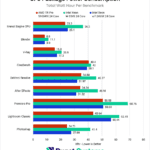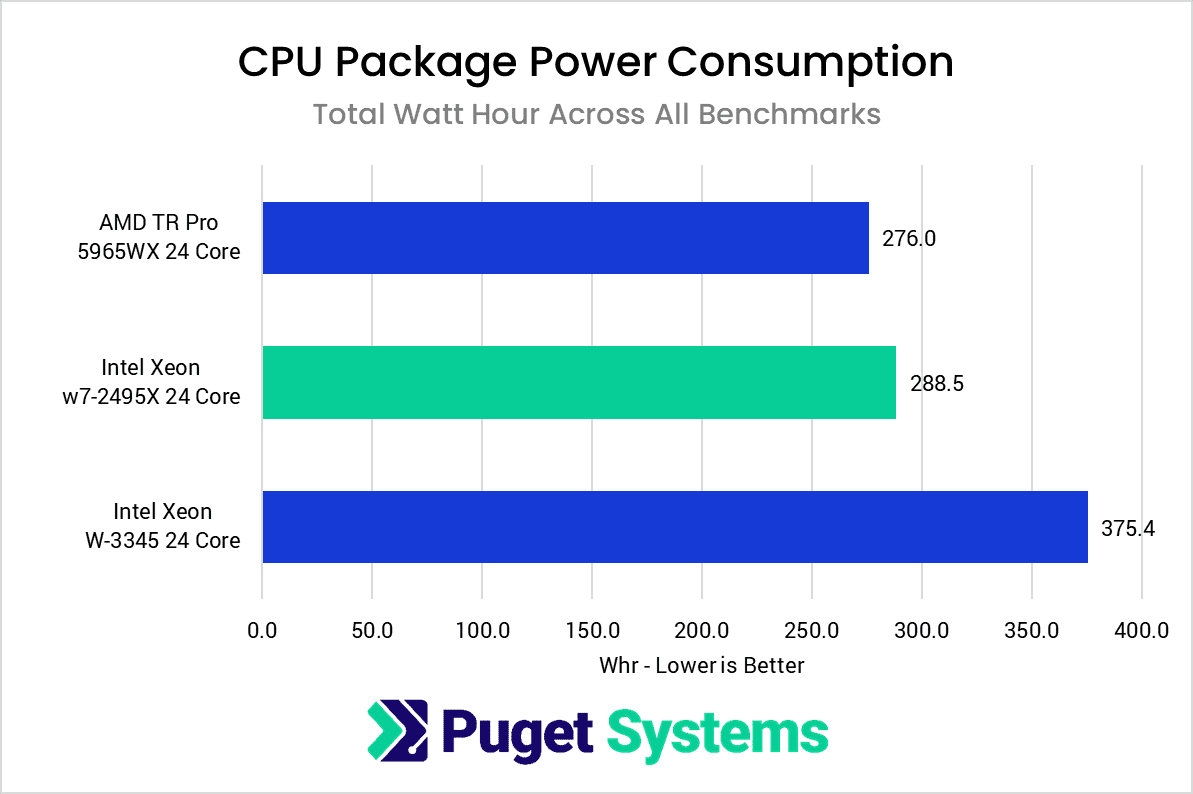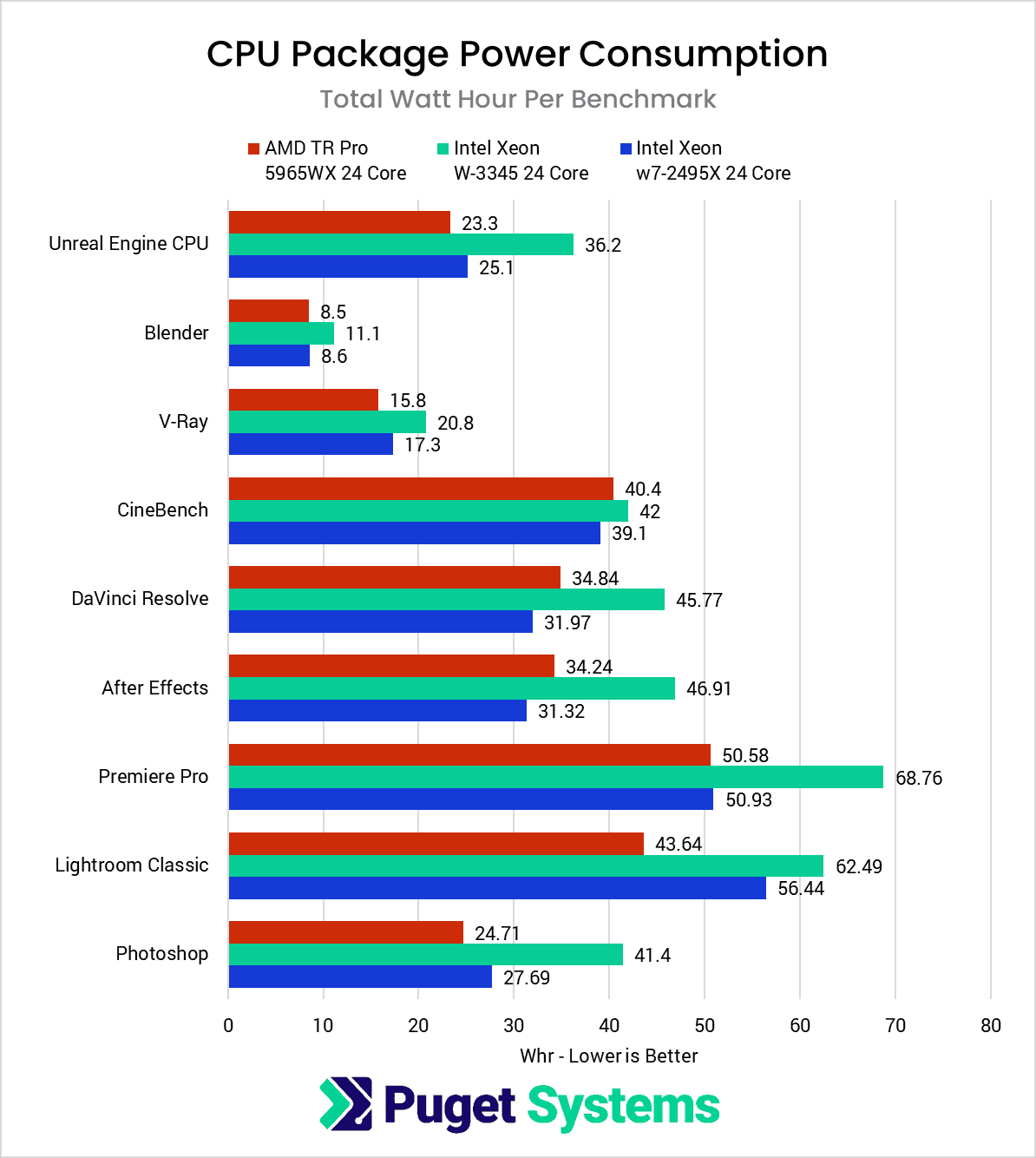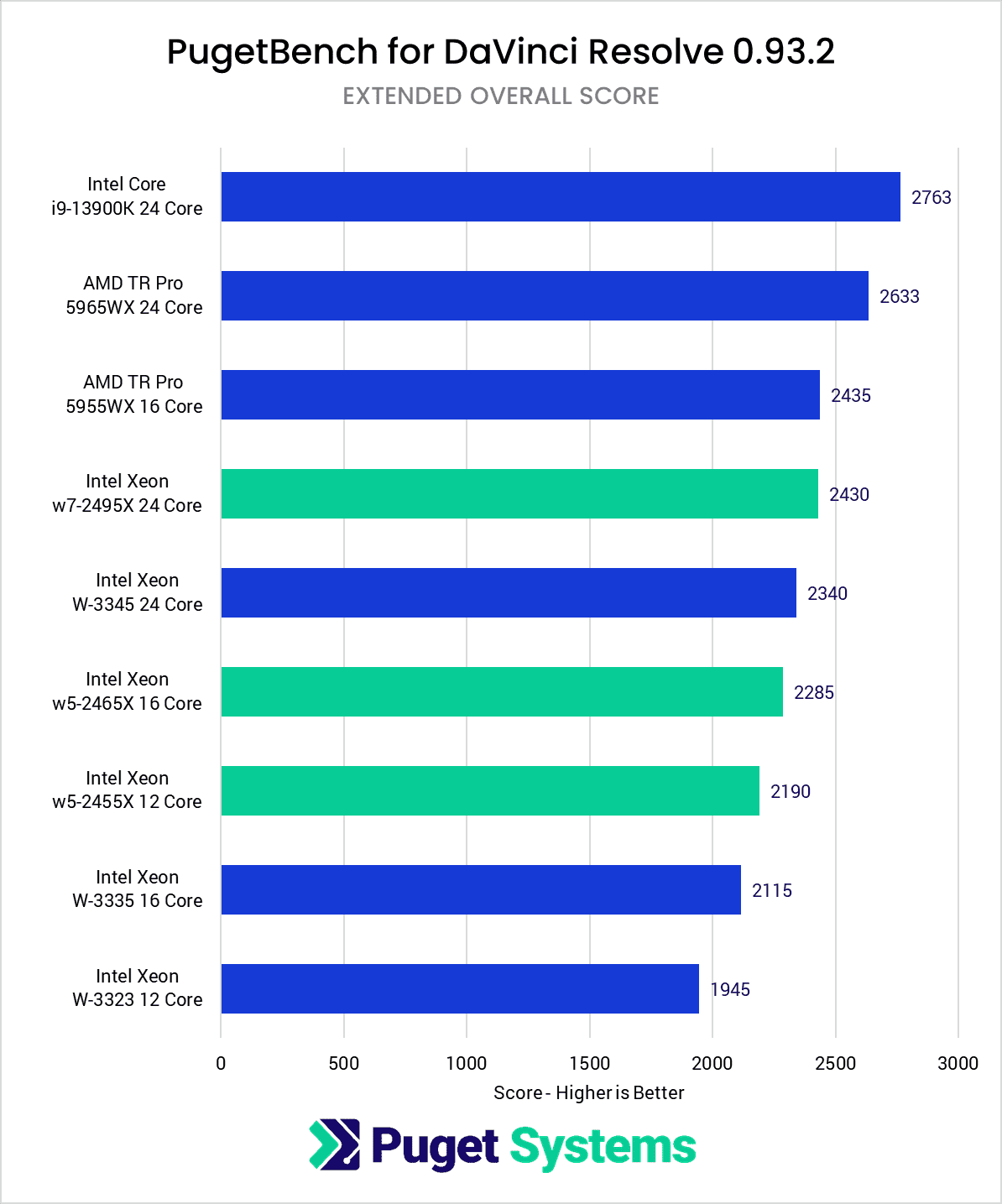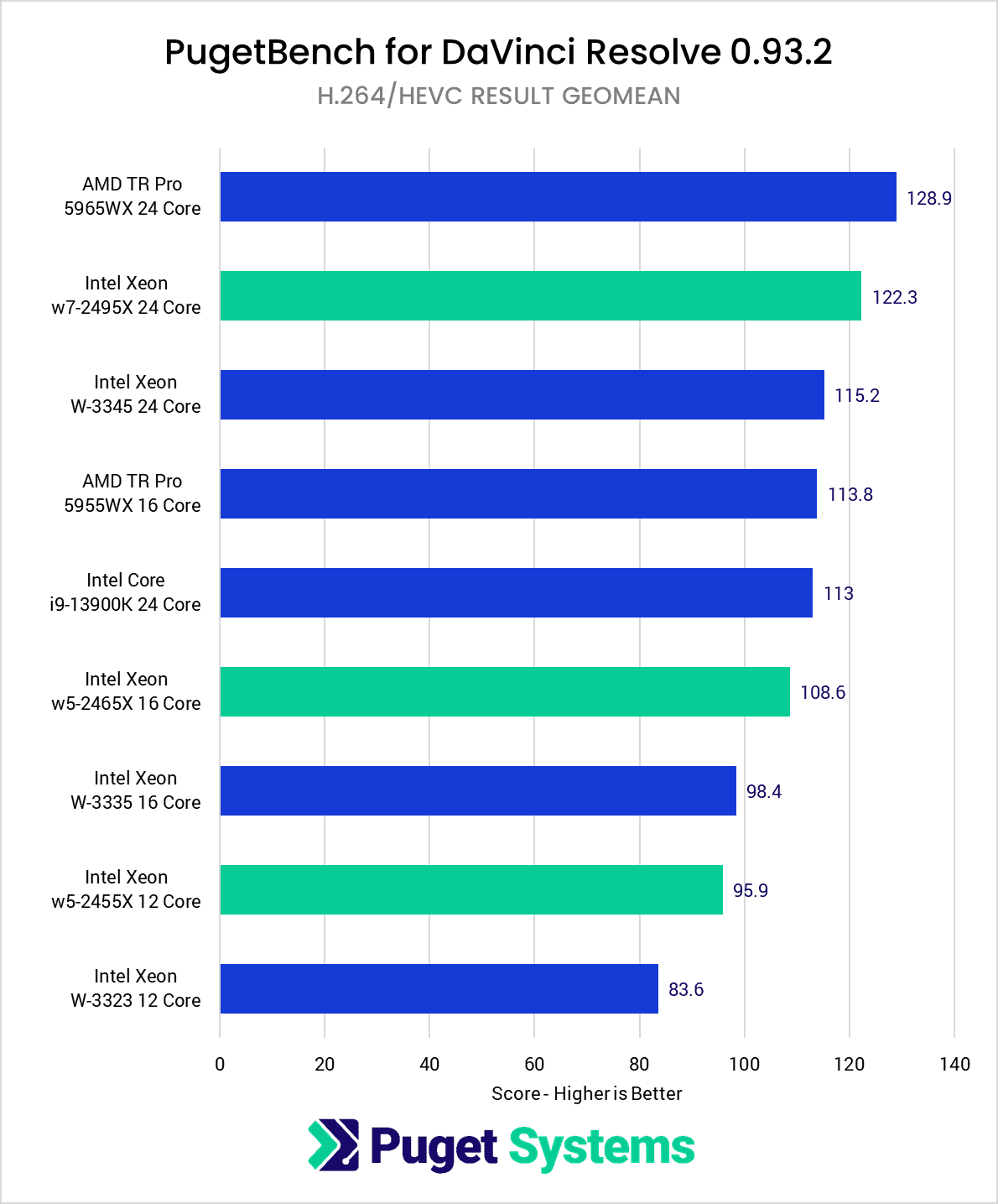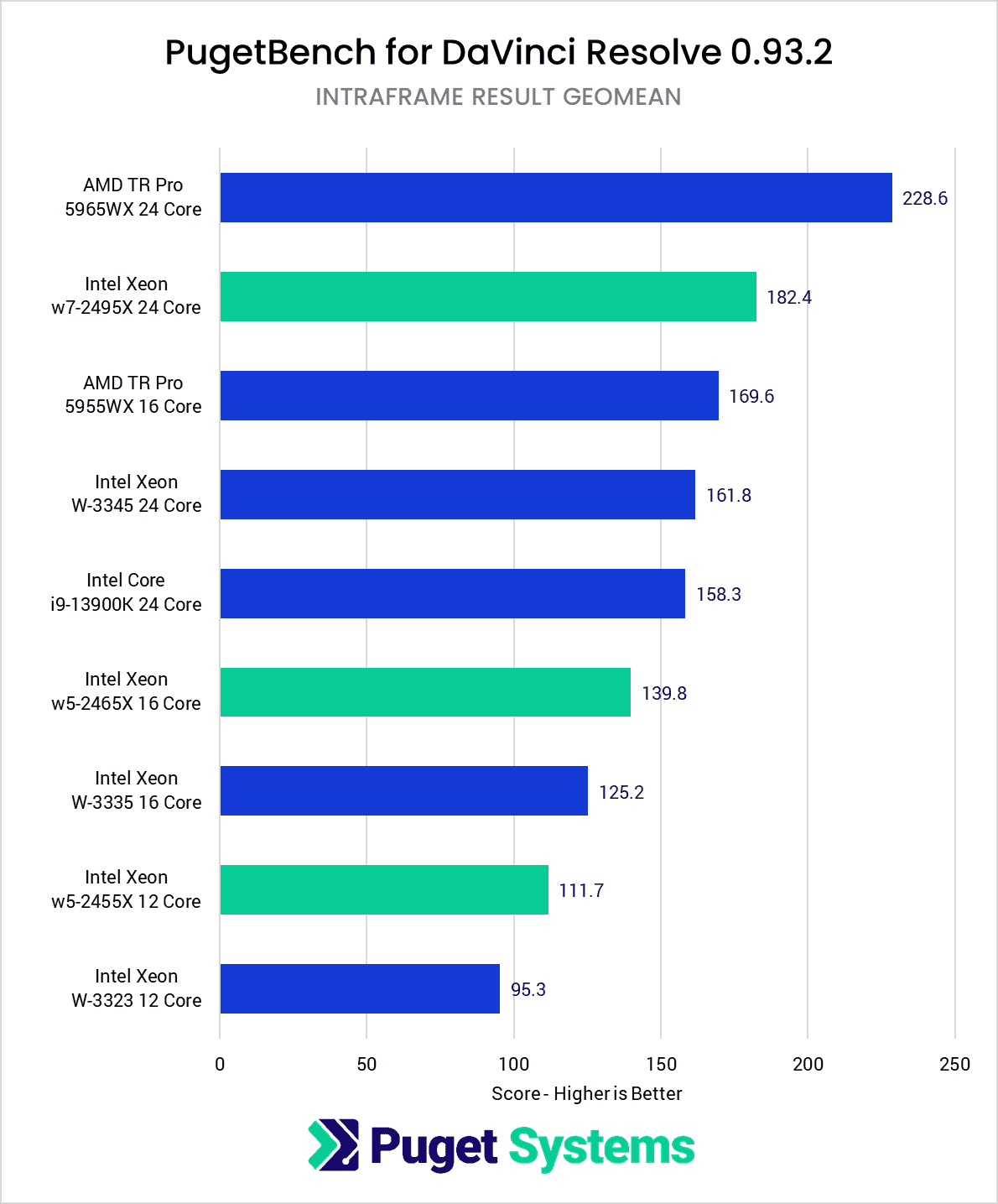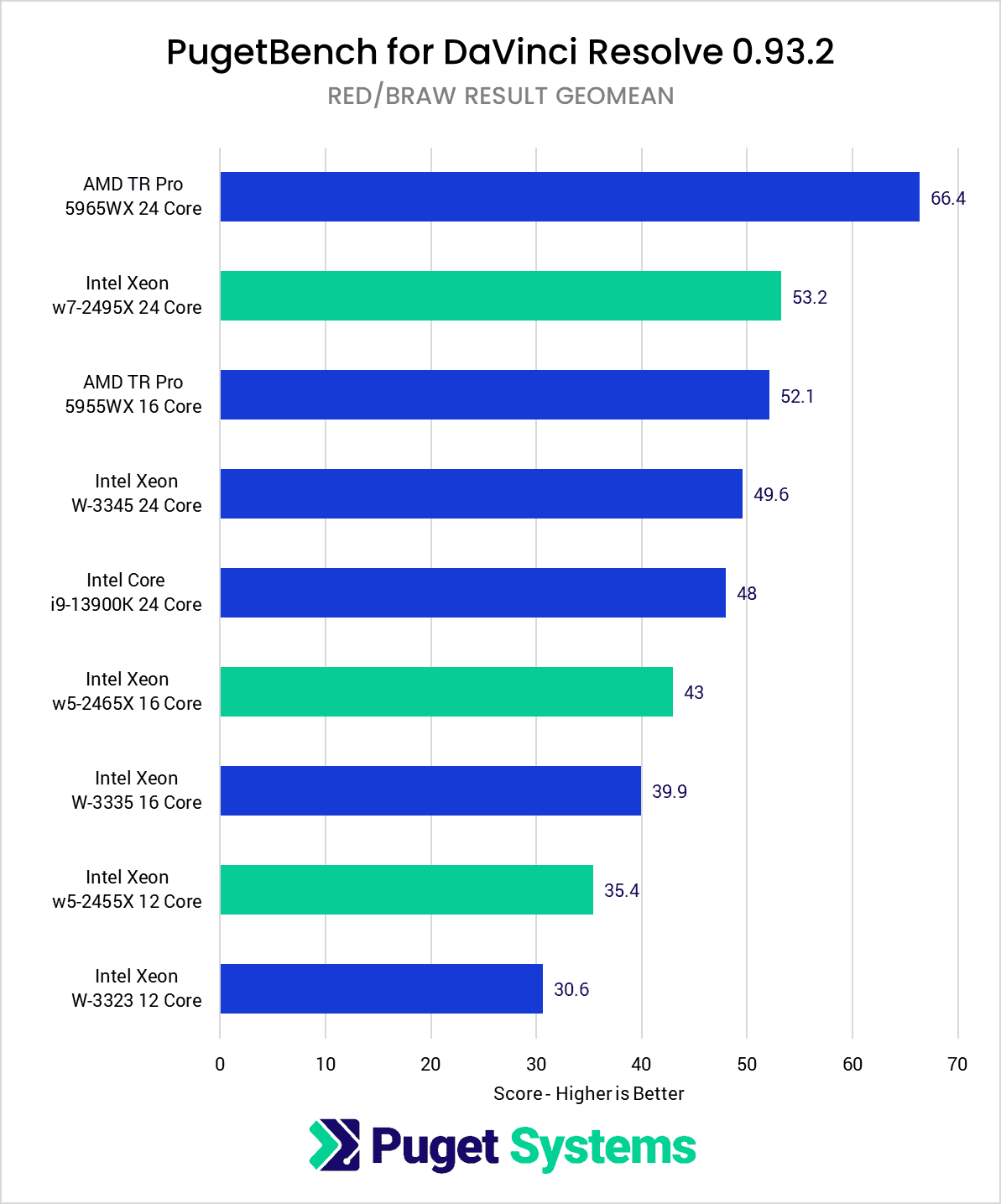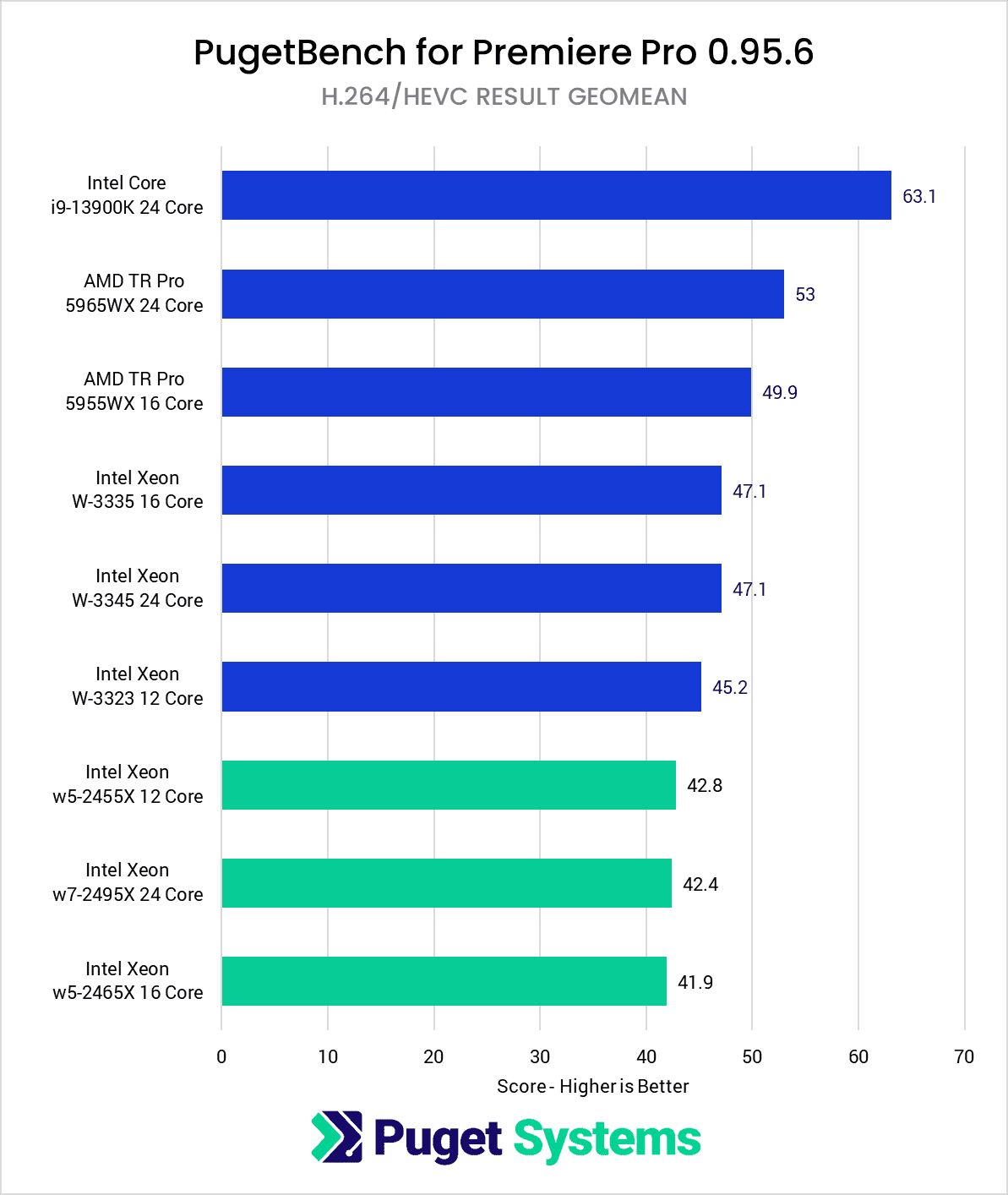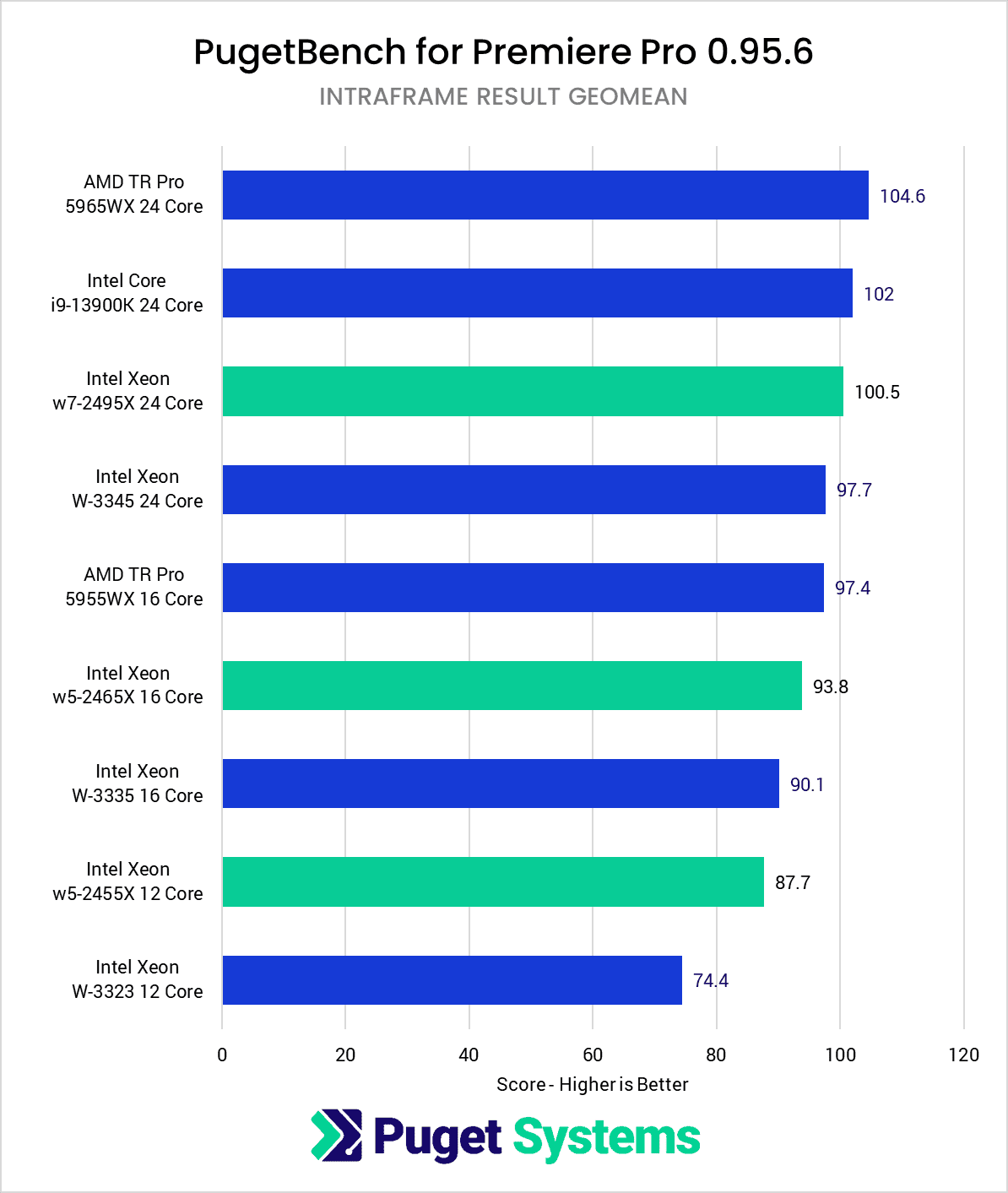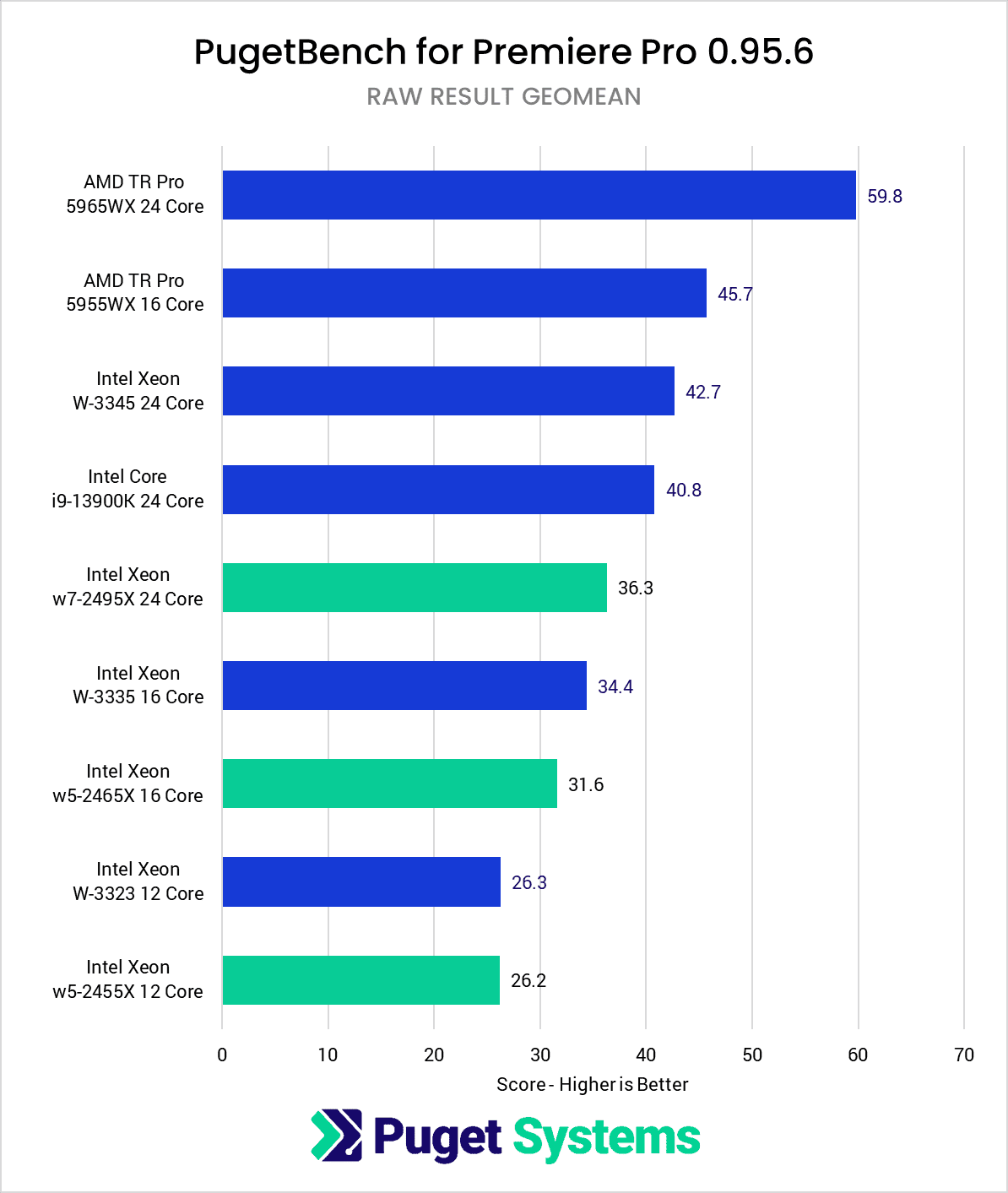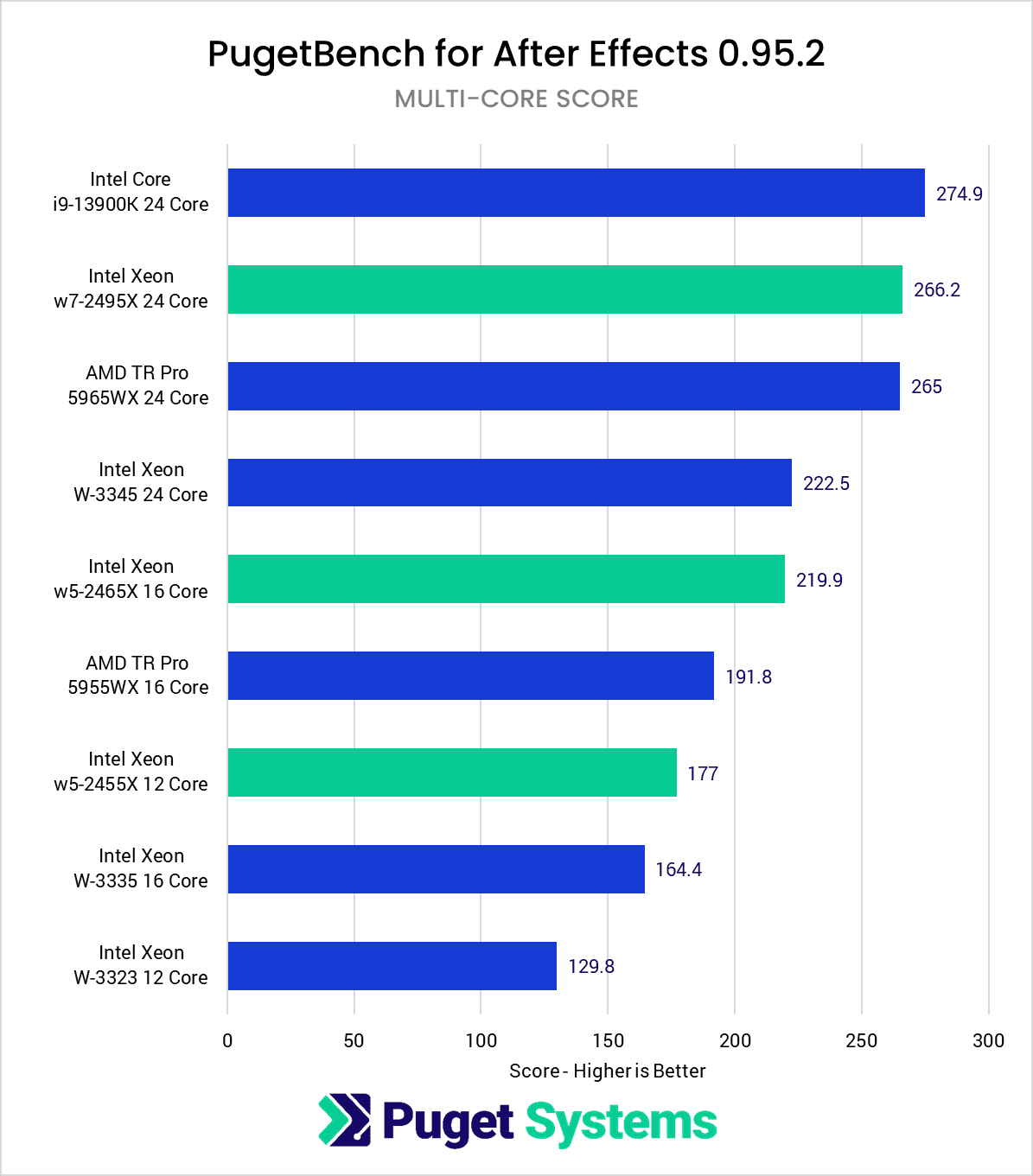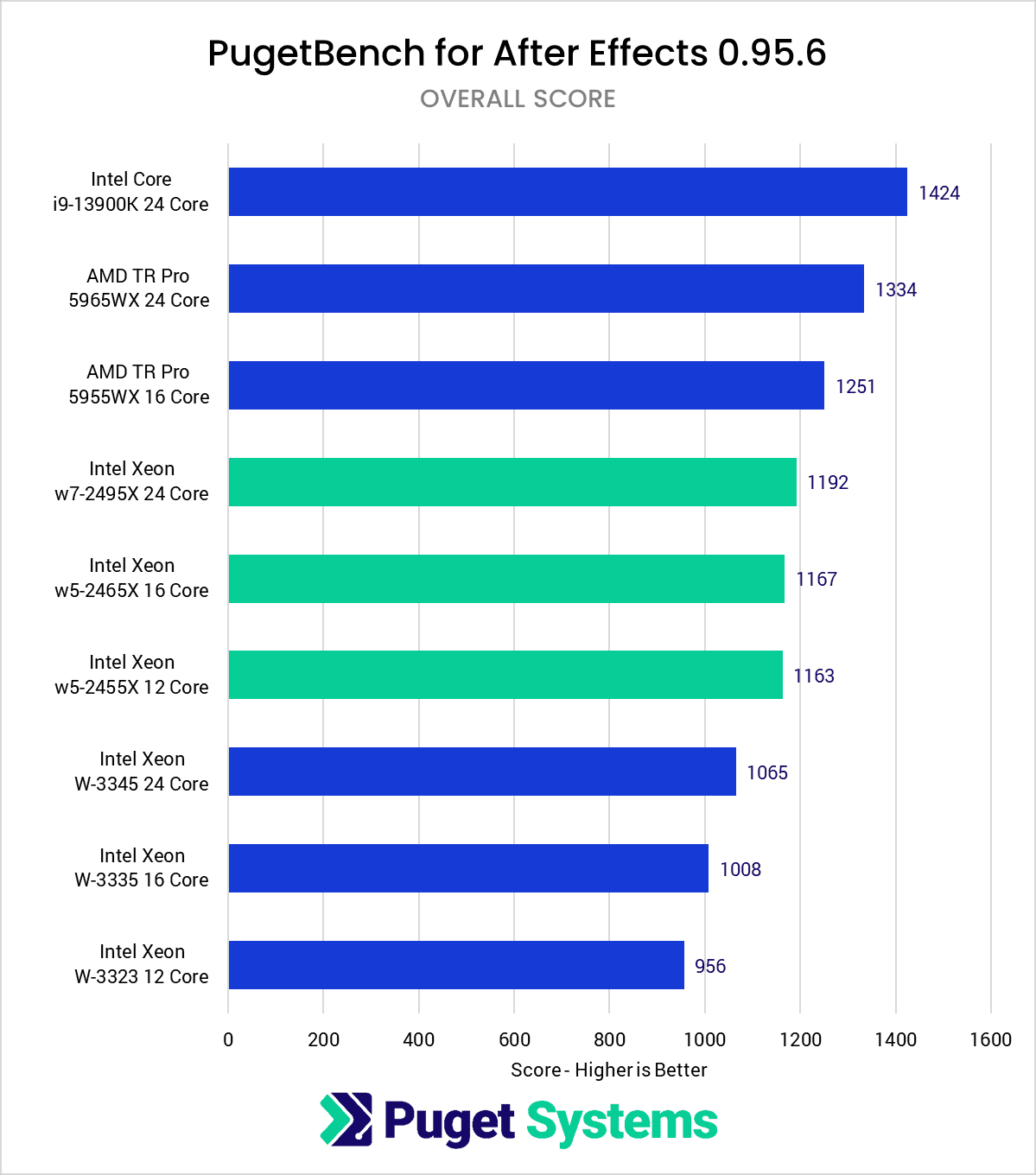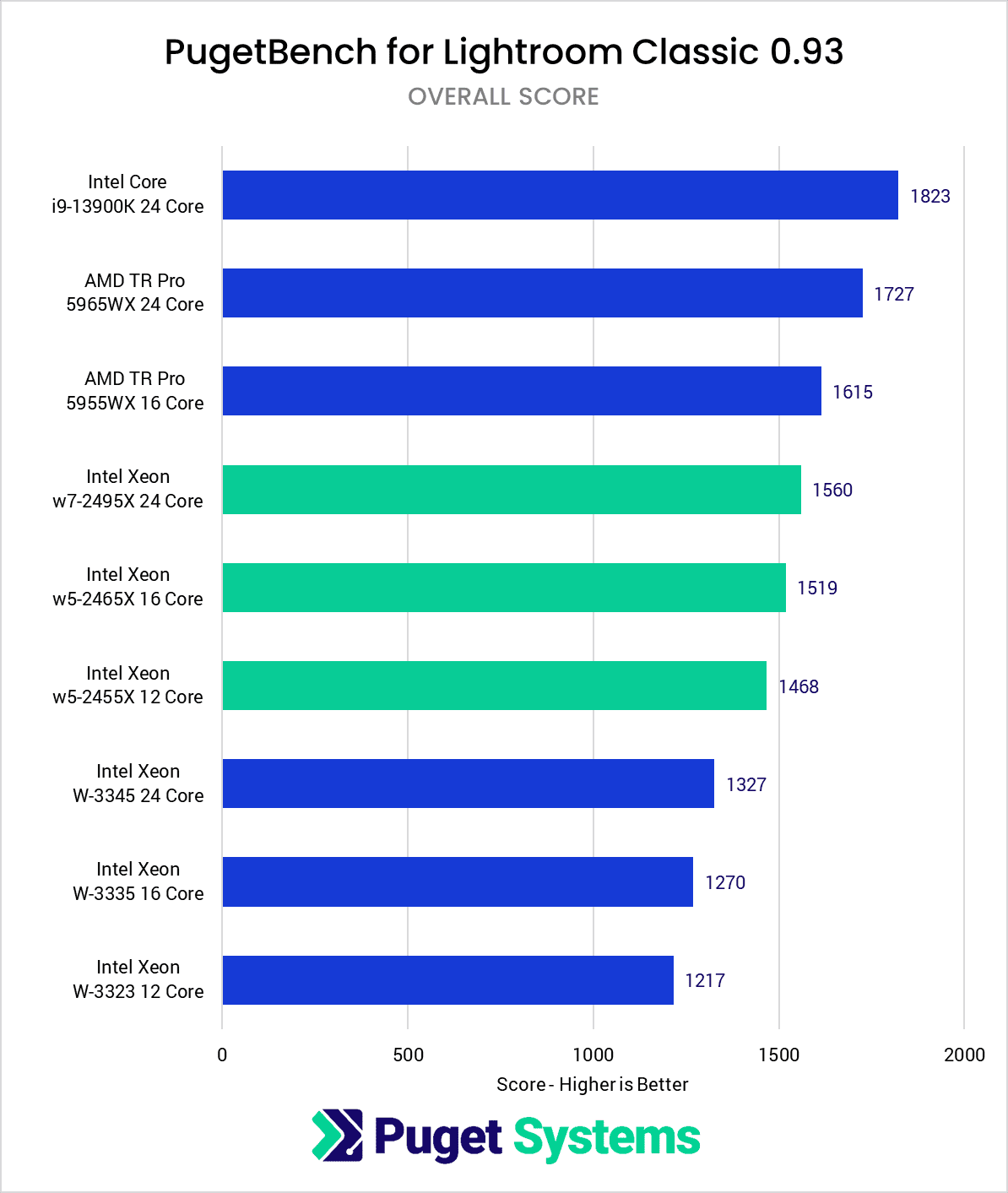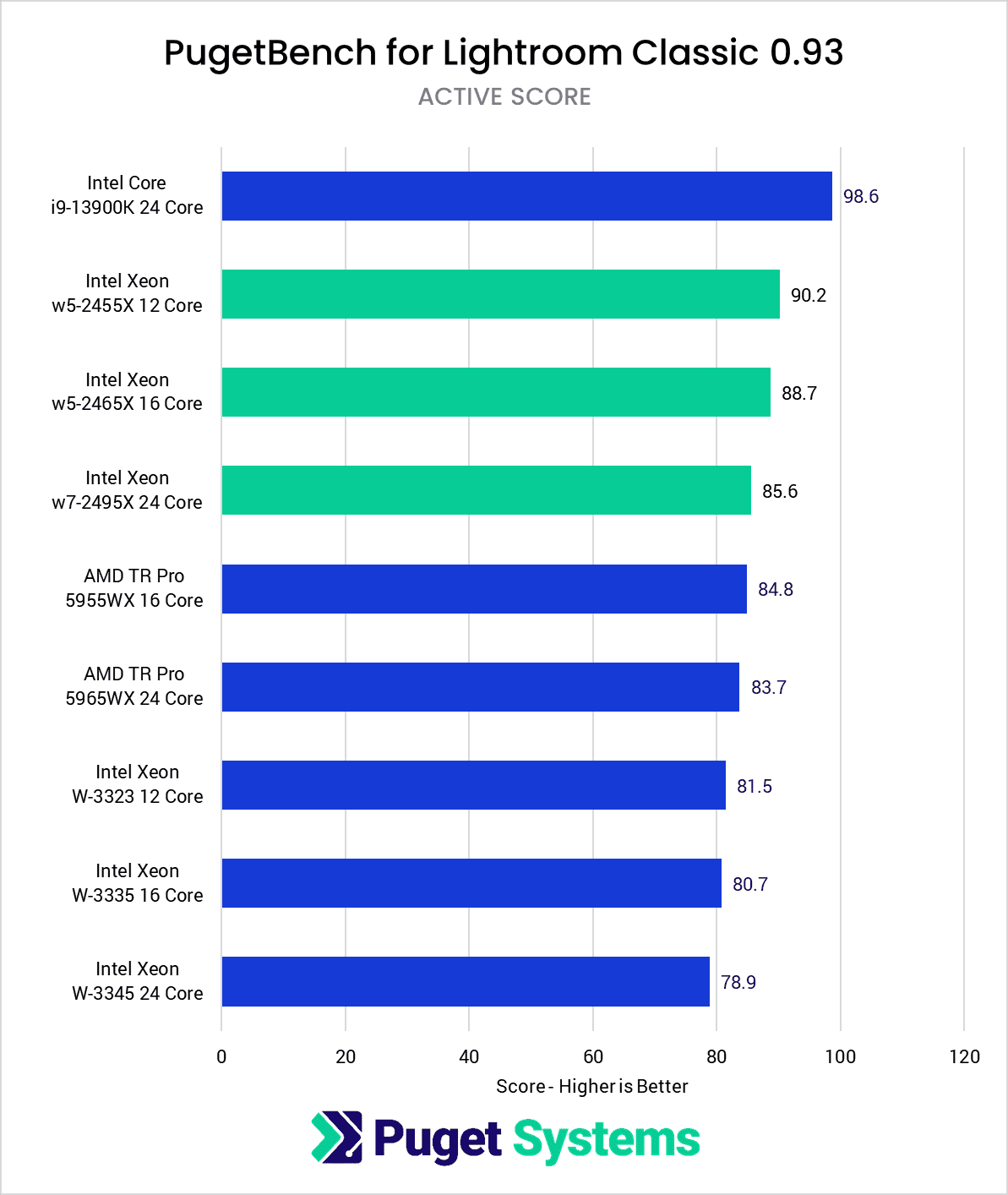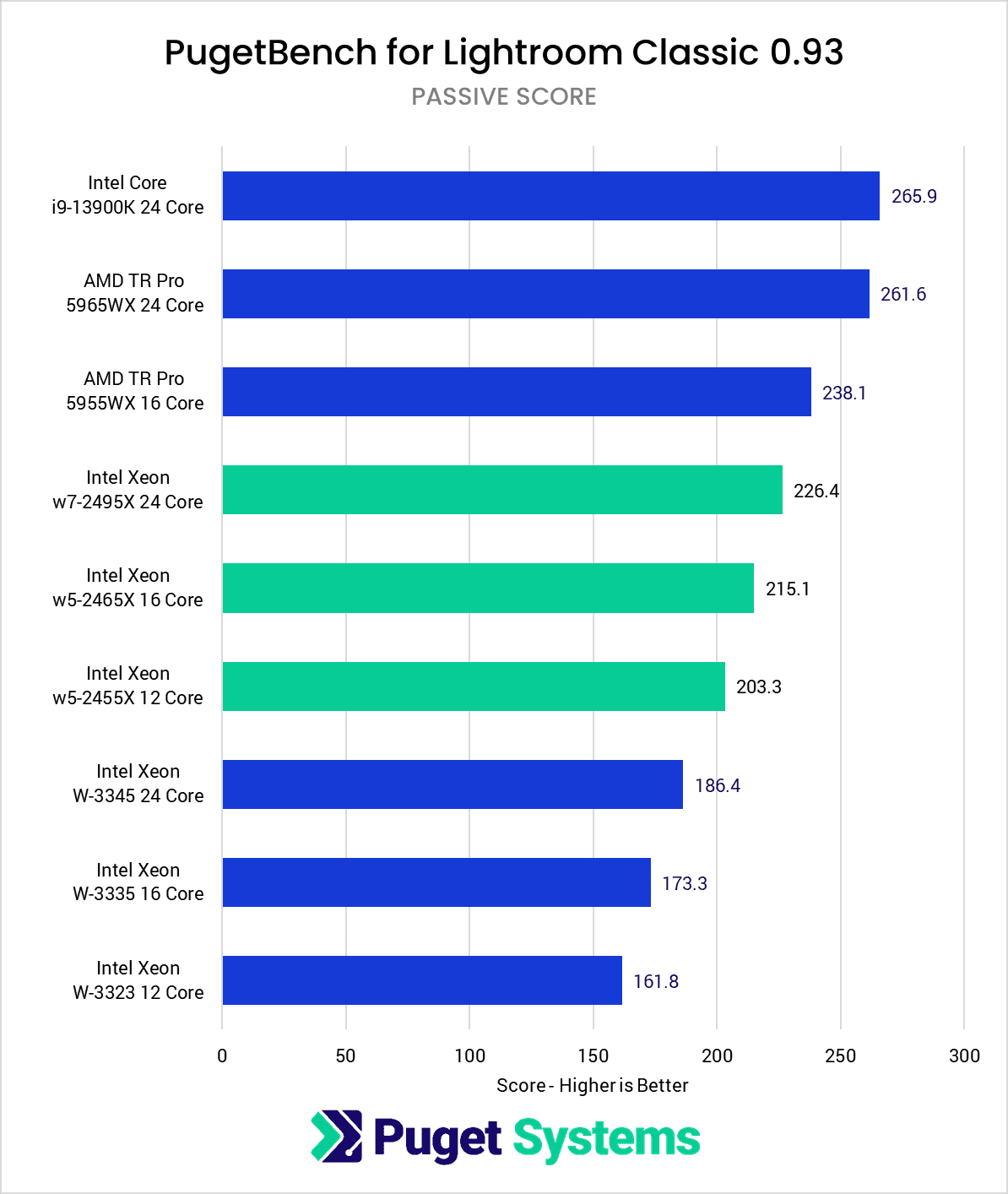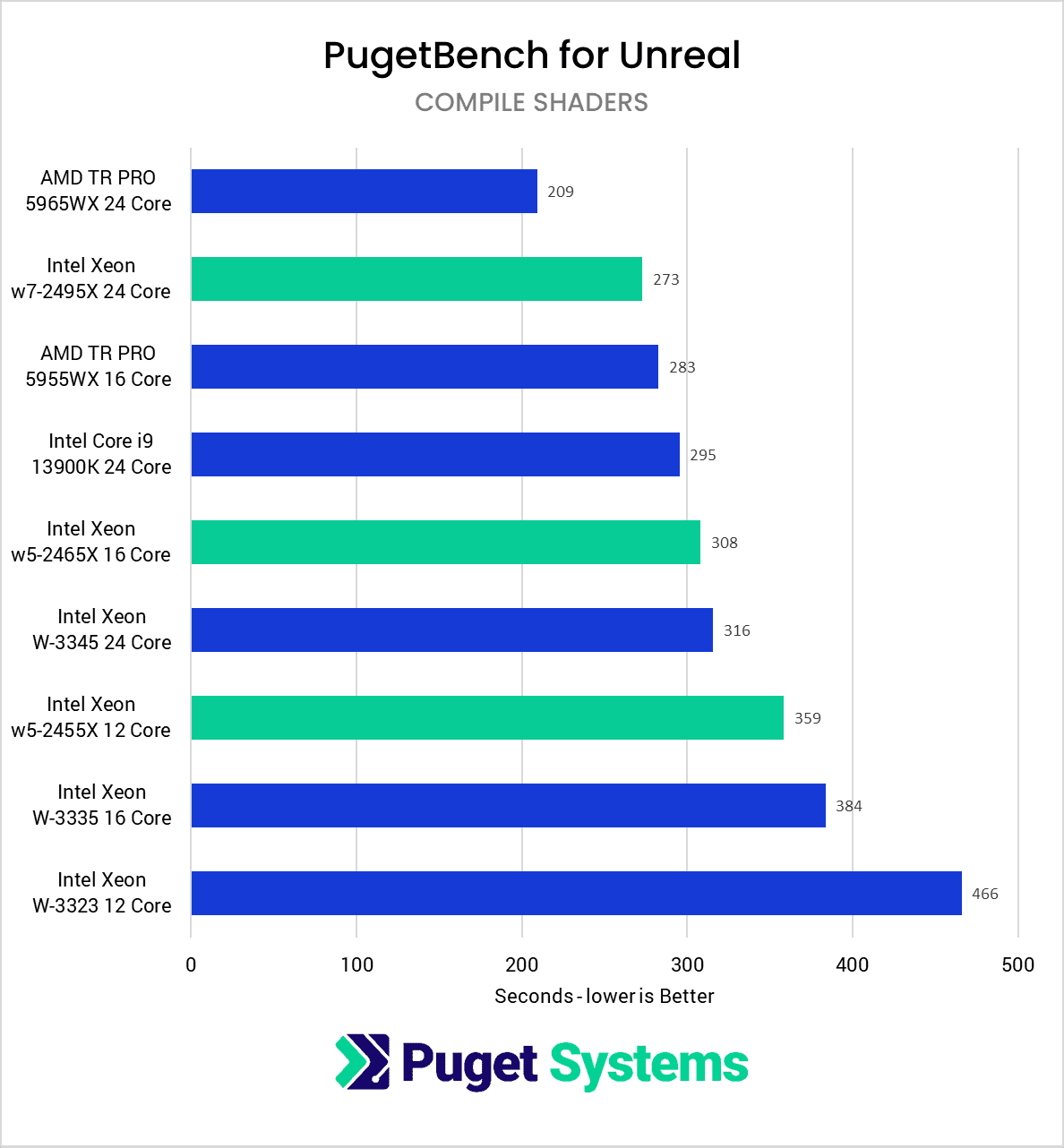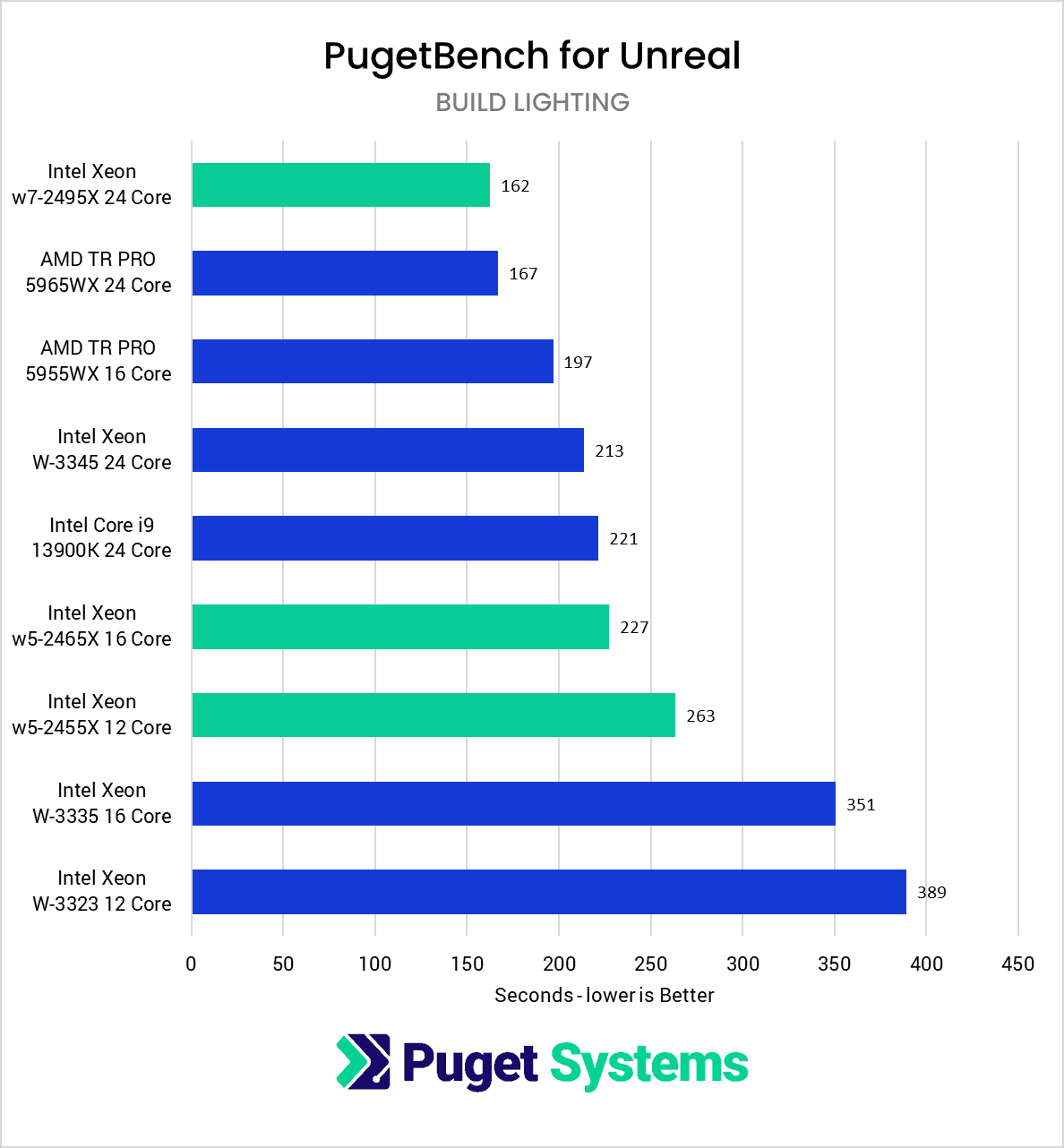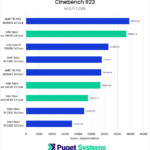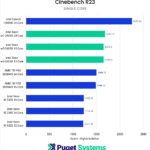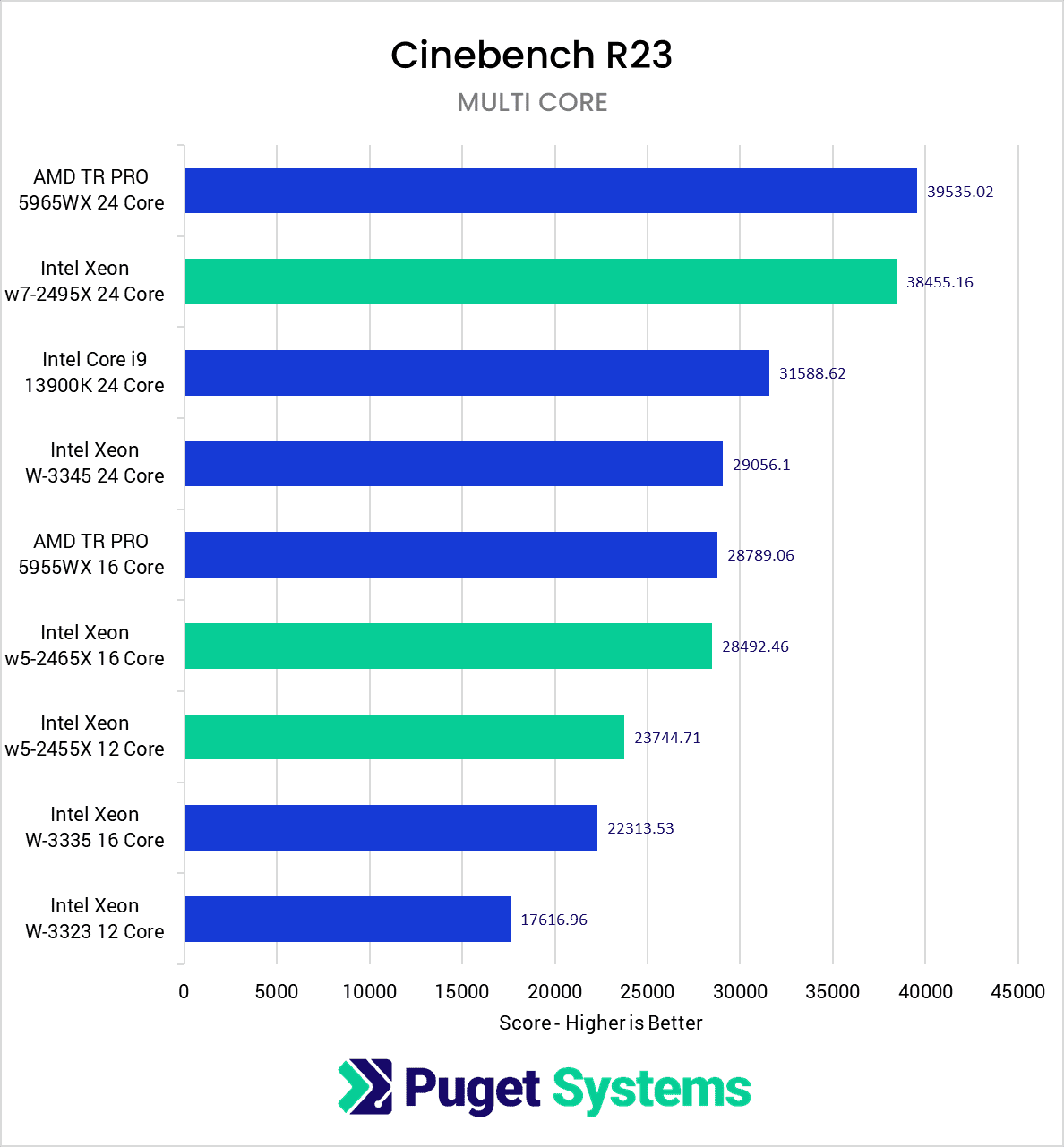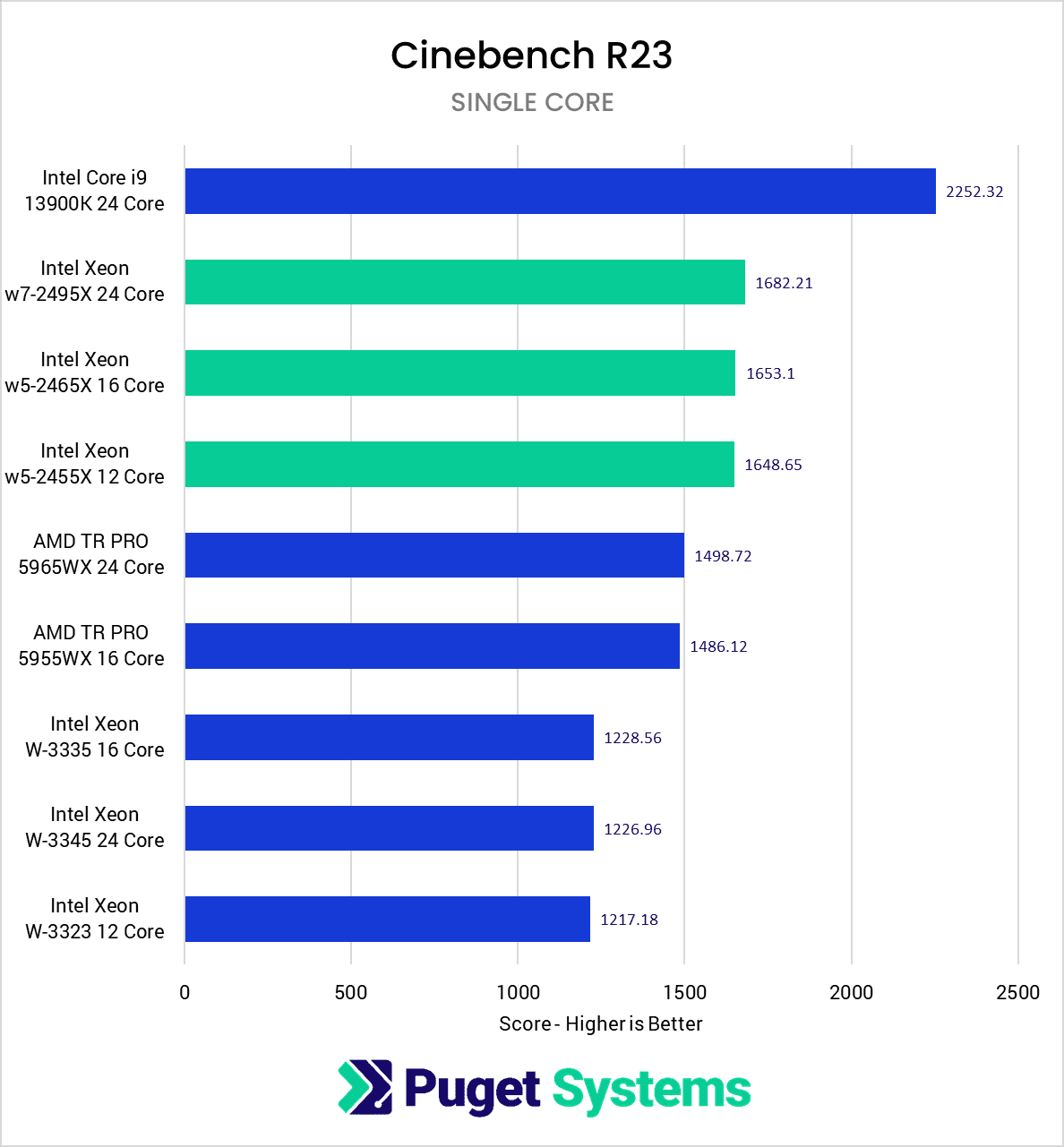Table of Contents
TL;DR: Intel Xeon W-2400 vs. AMD Threadripper PRO 5000 WX-Series for Content Creation
Overall, the new Intel Xeon W-2400 series of processors brings terrific performance gains over the previous generation, along with significantly reduced power consumption. For the Xeon w7-2495 24-core, we saw nearly a 20% increase in performance in lightly threaded applications like Photoshop and Lightroom Classic, and more than a 30% gen-over-gen improvement in heavily threaded tasks like CPU rendering and certain parts of Unreal Engine.
Unfortunately, however, there are a number of rough spots – such as working with RAW media in applications like DaVinci Resolve and Premiere Pro – where these processors show either minimal gains, or even a slightly loss of performance compared to the previous generation.
In general, while the new Xeon W-2400 series is a giant leap in the right direction for Intel, they at best, are only able to match AMD’s Threadripper PRO CPUs, and in some areas, still have more work to do before they are a viable option. The good news is that this means that for many workflows, we are back to having multiple option to choose from. We are no longer locked into AMD Threadripper PRO, and you can choose between AMD and Intel based on how the entire platform (not just the raw performance) best fits your entire workflow. But for other workflows, AMD continues to hold a solid performance lead.
Introduction
In February, Intel announced their new “Sapphire Rapids” Xeon family of processors, encompassing the Intel Xeon W-2400, Intel Xeon W-3400, and the 4th Gen Intel Xeon Scalable processors. As is often the case with this class of product, however, the announcement was well ahead of the review embargo and even further ahead of the sales embargo (when end users can actually get their hands on it).
We had the opportunity to publish a preview of the W-3400 processors recently, where we took a look at the current state of performance at that time. But, since those results were with pre-launch CPUs, motherboards, and BIOS versions, so while interesting, they couldn’t be used as final performance numbers. Today, however, we are going to take a close look at the fully launched mainstream W-2400 line, which is available for the public to buy right now.
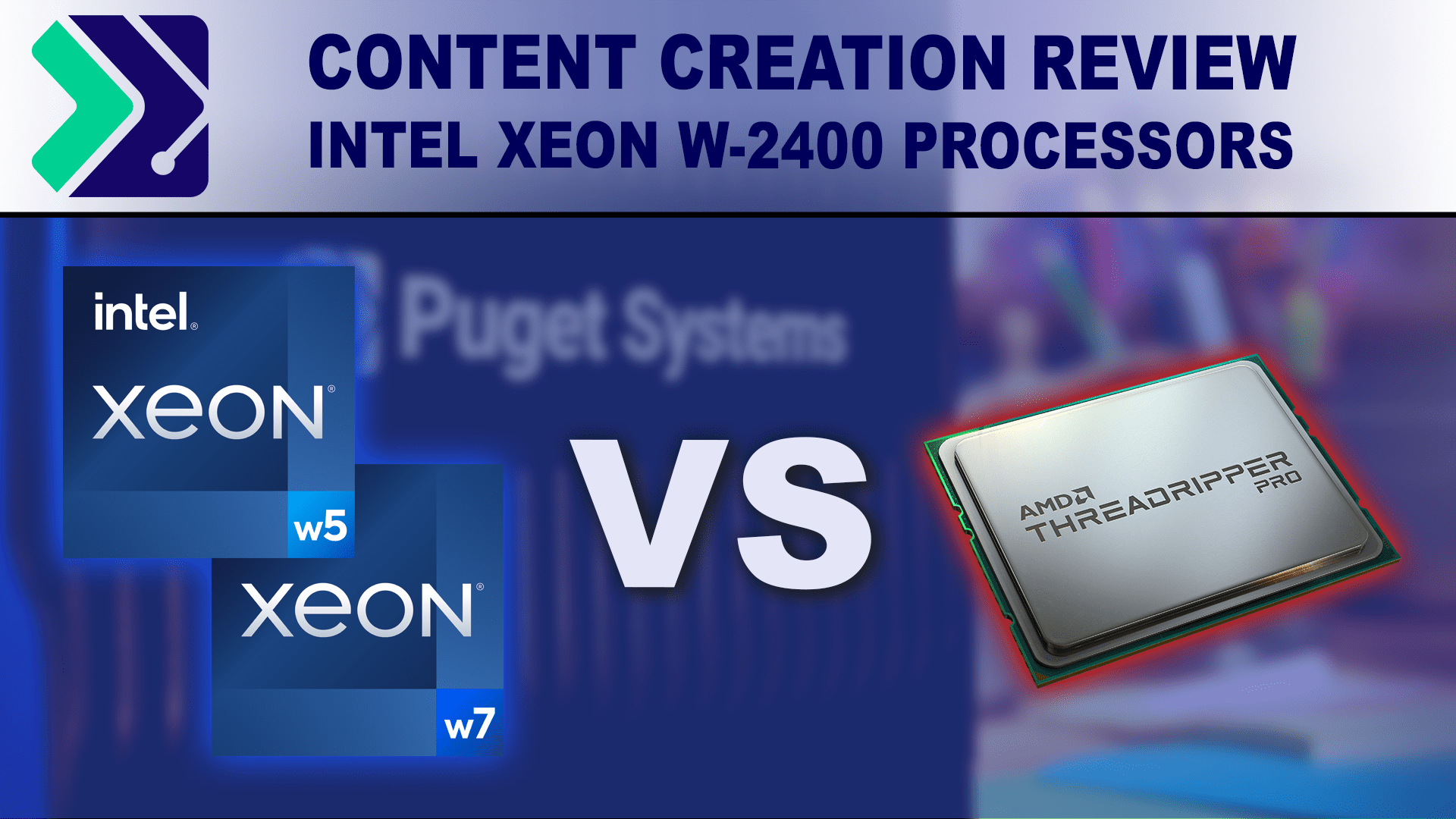
Interestingly, Intel hasn’t said much about the performance of the Xeon W-2400 processors in their launch materials. The official launch announcement for these CPUs claimed “up to 28% single-thread1 and up to 120% multithread performance improvements2 over the previous generation”, but that was just for the Xeon w9-3945X 56 Core, and compared it to the lower core count Xeon W-3275 28 Core from the previous generation. All we can really infer from that is that the W-2400 should have much better single-threaded performance than the previous generation, but it is hard to guess how they will do for moderately- and heavily-threaded workloads.
Before we get too far into this article, however, we want to clarify the difference between the W-2400 and W-3400 product lines, because, at first glance, they seem very similar:
| Intel Xeon W Specs | Intel Xeon W-2400 (Mainstream Workstation Processors) | Intel Xeon W-3400 (Expert Workstation 1S Processors) |
|---|---|---|
| Socket | LGA 4677 | LGA 4677 |
| CPU PCIe Lanes | 64 | 112 |
| Memory Channels | 4 | 8 |
| Max Cores/Threads | 24/48 | 56/112 |
| Base Power | 110-225W | 270-350W |
| Max Memory | 2TB DDR5 | 4TB DDR5 |
| Overclocking | Select Models | Select Models |
As you can see, the W-2400 line is in large part a trimmed-down version of the W-3400 processors. Half the memory channels and maximum memory capacity, a bit less than half the maximum core count, and a bit more than half the PCIe lanes. Both lines use the LGA 4677 socket, although the heat spreaders are physically different, so you need a different heatsink carrier clip for each line.
CPUs from each line can go into the same motherboard, although things like the memory channels and PCIe lanes could mean that some features may not work. For example, the ASUS Pro WS W790E-SAGE SE motherboard we are using has eight RAM slots, but with a W-2400 CPU, only half of them were functional.
Intel tends to provide a very broad product offering for Xeon, and these new lines are no different, with eight models in the W-2400 line, and seven in the W-3400 line. This results in a large list of total CPUs, but in the chart below, we flagged the W-2400 in particular since those are what we are focusing on today. If you want to see the full specs of these new Intel Xeon W-2400 CPUs, we recommend checking out the Intel Ark page for Xeon W Processors.
| CPU Specs | Cores/ Threads | Smart Cache (L3) | Max Frequency | Base Frequency | Max Memory Speed | Unlocked | Power (Base/Max) | MSRP |
|---|---|---|---|---|---|---|---|---|
| TR PRO 5995WX | 64/128 | 256MB | 4.5GHz | 2.7GHz | DDR4 3200 | Yes | 280W | $6,499 |
| w9-3495X | 56/112 | 105MB | 4.8GHz | 1.9GHz | DDR5 4800 | Yes | 350/420W | $5,889 |
| W-3375 | 38/76 | 57MB | 4.0GHz | 2.5GHz | DDR4 3200 | No | 270W | $4,951 |
| W-3365 | 32/34 | 48MB | 4.0GHz | 2.7GHz | DDR4 3200 | No | 270W | $3,851 |
| w9-3475X | 36/72 | 82.5MB | 4.8GHz | 2.2GHz | DDR5 4800 | Yes | 300/360W | $3,739 |
| TR PRO 5975WX | 32/64 | 128MB | 4.5GHz | 3.6GHz | DDR4 3200 | Yes | 280W | $3,299 |
| w7-3465X | 28/56 | 75MB | 4.8GHz | 2.5GHz | DDR5 4800 | Yes | 300/360W | $2,889 |
| W-3345 | 24/48 | 36MB | 4.0GHz | 3.0GHz | DDR4 3200 | No | 250W | $2,751 |
| w7-3455 | 24/48 | 67.5MB | 4.8GHz | 2.5GHz | DDR5 4800 | No | 270/324W | $2,489 |
| TR PRO 5965WX | 24/48 | 128MB | 4.5GHz | 4.0GHz | DDR4 3200 | Yes | 280W | $2,399 |
| w7-2495X | 24/48 | 45MB | 4.8GHz | 2.5GHz | DDR5 4800 | Yes | 225/270W | $2,189 |
| w7-3445 | 20/40 | 52.5MB | 4.8GHz | 2.6GHz | DDR5 4800 | No | 270/324W | $1,989 |
| w7-2475X | 20/40 | 37.5MB | 4.8GHz | 2.6GHz | DDR5 4800 | Yes | 225/270W | $1,799 |
| w5-3435X | 16/32 | 45MB | 4.7GHz | 3.1GHz | DDR5 4800 | Yes | 270/324W | $1,589 |
| W-3335 | 16/32 | 24MB | 4.0GHz | 3.4GHz | DDR4 3200 | No | 250W | $1,430 |
| w5-2465X | 16/32 | 33.75MB | 4.6GHz | 3.1GHz | DDR5 4800 | Yes | 200/240W | $1,399 |
| TR PRO 5955WX | 16/32 | 64MB | 4.5GHz | 4.0GHz | DDR4 3200 | Yes | 280W | $1,299 |
| w5-3425 | 12/24 | 30MB | 4.6GHz | 3.2GHz | DDR5 4800 | No | 270/324W | $1,189 |
| w5-2455X | 12/24 | 30MB | 4.6GHz | 3.2GHz | DDR5 4800 | Yes | 200/240W | $1,049 |
| W-3323 | 12/24 | 21MB | 3.9GHz | 3.5GHz | DDR4 3200 | No | 220W | $1,043 |
| w5-2445 | 10/20 | 26.25MB | 4.6GHz | 3.1GHz | DDR5 4800 | No | 175/210W | $839 |
| w3-2435 | 8/16 | 22.5MB | 4.5GHz | 3.1GHz | DDR5 4400 | No | 165/198W | $669 |
| w3-2425 | 6/12 | 15MB | 4.4GHz | 3.0GHz | DDR5 4400 | No | 130/156W | $529 |
| w3-2423 | 6/12 | 15MB | 4.2GHz | 2.1GHz | DDR5 4400 | No | 120/144W | $359 |
Compared to the previous W-3300 line, the new W-2400 processors are a bit less expensive per core at the top end, and very similar around the 12 core mark. Interestingly, Intel is providing a number of lower-end models this time around – all the way down to a 6 core model for just $359. These models should be a terrific option for GPU-focused workloads like GPU rendering where the CPU primarily just functions as a traffic controller. Being able to get 64 PCIe lanes for $359 could make Intel a clear choice over AMD for those types of workloads.
We will note, however, that MSRP can be misleading for this type of product, as these CPUs are intended to primarily be sold as a part of an entire workstation and not as an individual part. Because of that, pricing can change based on numerous deals system integrators may have access to but are also impacted by the markup applied by those same integrators.
In terms of specs, the W-2400 CPUs are very similar to their W-3400 counterparts at the same core count, although it is interesting how much lower the wattage is. The w5-2455X, for example, is almost identical to the w7-3425 in terms of base specs, only with a dramatically lower power draw. True, it has less PCIe lanes and memory channels, but a 70-84W difference is pretty significant if you don’t need those additional features.
Test Setup
Intel Xeon W-2400 Test Platform
| CPUs: Intel Xeon w7-2495X 24 Core Intel Xeon w5-2465X 16 Core Intel Xeon w5-2455X 12 Core |
| CPU Cooler: Noctua NH-U14S DX-4677 |
| Motherboard: ASUS Pro WS W790E-SAGE SE |
| Power Profile: High Performance |
| RAM: 4x Kingston DDR5-4800 ECC Reg. 1R 16GB (64GB total) |
| GPU: NVIDIA GeForce RTX 4080 16GB |
| PSU: Super Flower LEADEX Platinum 1600W |
| Storage: Samsung 980 Pro 2TB |
| OS: Windows 11 Pro 64-bit (22621) |
Intel Xeon W-3300 Test Platform
| CPUs: Intel Xeon W-3345 24 Core Intel Xeon W-3335 16 Core Intel Xeon W-3323 12 Core |
| CPU Cooler: Noctua NH-U14S DX-4189 |
| Motherboard: Supermicro X12SPA-TF 64L |
| Power Profile: High Performance |
| RAM: 8x Kingston DDR4-3200 ECC Reg. 1R 16GB (128GB total) |
| GPU: NVIDIA GeForce RTX 4080 16GB |
| PSU: Super Flower LEADEX Platinum 1600W |
| Storage: Samsung 980 Pro 2TB |
| OS: Windows 11 Pro 64-bit (22621) |
AMD Threadripper PRO Test Platform
| CPU: AMD Threadripper PRO 5965WX 24 Core AMD Threadripper PRO 5955WX 16 Core |
| CPU Cooler: Noctua NH-U14S TR4-SP3 (AMD TR4) |
| Motherboard: Asus Pro WX WRX80E-SAGE SE WIFI |
| Power Profile: Balanced |
| RAM: 8x Micron DDR4-3200 16GB ECC Reg. (128GB total) |
| GPU: NVIDIA GeForce RTX 4080 16GB |
| PSU: Super Flower LEADEX Platinum 1600W |
| Storage: Samsung 980 Pro 2TB |
| OS: Windows 11 Pro 64-bit (22621) |
Intel Core 13th Gen Test Platform
| CPU: Intel Core i9 13900K 24 Core |
| CPU Cooler: Noctua NH-U12A |
| Motherboard: Asus ProArt Z690E-Creator WiFi |
| Power Profile: Balanced |
| RAM: 2x DDR5-4800 32GB (64GB total) |
| GPU: NVIDIA GeForce RTX 4080 16GB |
| PSU: Super Flower LEADEX Platinum 1600W |
| Storage: Samsung 980 Pro 2TB |
| OS: Windows 11 Pro 64-bit (22621) |
Benchmark Software
| Photoshop 24.1.1 – PugetBench for Photoshop 0.93.6 |
| Lightroom Classic 12.2 – PugetBench for Lightroom Classic 0.94 |
| After Effects 23.2 – PugetBench for After Effects 0.95.6 |
| Premiere Pro 23.1.0 – PugetBench for Premiere Pro 0.95.6 |
| DaVinci Resolve 18.1.3 – PugetBench for DaVinci Resolve 0.93.2 |
| Unreal Engine 4.26 |
| Cinebench R23.2 |
| Blender 3.4.0 |
| V-Ray 5.02.00 |
To see how the new Xeon W-2400 processors perform, we will primarily compare them to similar core count models from the previous generation W-3300 line and AMD’s Threadripper PRO 5000 Series processors. In addition, we will also toss the Intel Core i9 13900K into the mix. This CPU is from a completely different family and, in many ways, doesn’t belong in a comparison between Xeon and Threadripper PRO products as it has less memory capacity and far fewer PCIe lanes. However, CPUs like the Core i9 13900K tend to be much faster for lightly threaded workloads like Photoshop, so we wanted to include it to provide context for where you might want to invest in a Xeon or Threadripper PRO platform, and where a lower-cost option may be a better fit.
We will note that all our testing is done with workstation usage in mind. That doesn’t mean much for most Xeon and Threadripper PRO platforms since they are largely tuned out of the box for workstation use, but we disable auto-overclocking features like MCE, and enforce the P1/P2 power limits. We have a whole post going over why we do this if you want the details, but the summary is that it greatly reduces power draw and temperatures for a minimal impact on performance outside of a few highly threaded workloads.
For the Intel Xeon platforms, we will be using the “High Performance” Windows power profile. This doesn’t impact AMD Threadripper Pro or the Intel Core 13th Gen processors much, but as we will show in the next section, it makes a massive performance difference for Intel Xeon.
Beyond the CPU and motherboards, we will be standardizing on the same GPU (RTX 4080), storage (Samsung 980 Pro 2TB), and OS (Windows 11 with the latest updates). We will use many of our PugetBench series of benchmarks, and several CPU rendering benchmarks to see how they perform under highly threaded workloads.
Windows Power Profiles Impact on Xeon W-2400 Performance
Before getting into our benchmark result analysis, we want to investigate how the Windows power profile affects performance. This has been a major factor with Intel Xeon CPUs for the last several generations, with lightly & moderately threaded workloads in particular seeing significant performance issues if you use the default “Balanced” power profile in Windows. This setting is easy enough to change, but we generally perform our testing with as stock of settings as possible, so we wanted to take the time to show just how important it is to switch to the “High Performance” power profile for Intel Xeon processors.
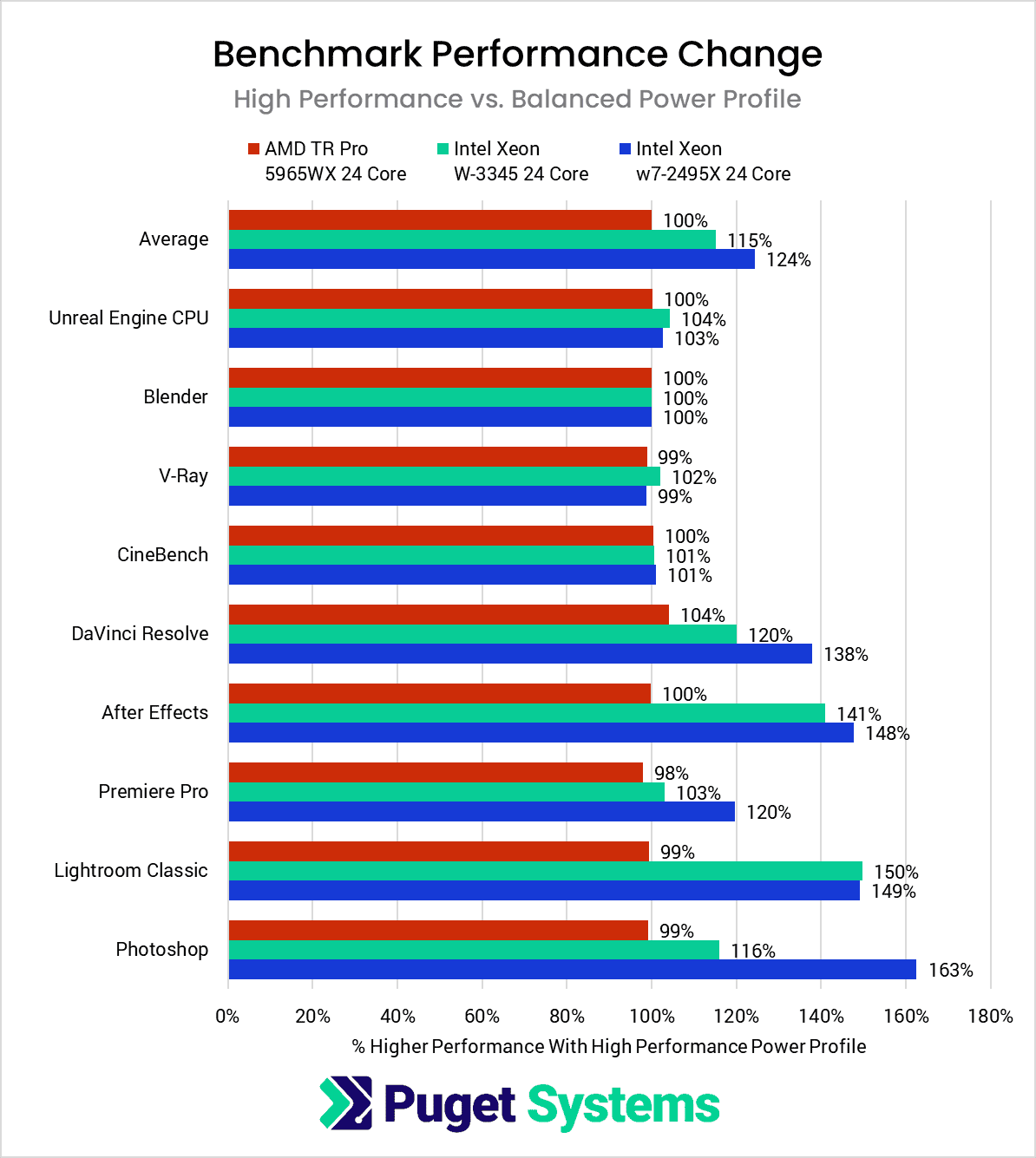
The chart above shows the increase in performance when we use the High Performance power profile rather than the Balanced profile. Anything above 100% indicates a performance increase with the change in power profile, while anything below 100% means there was actually a performance drop. In most cases, anything between 95-105% can be considered to be within the margin of error, and thus effectively unchanged.
On average, we saw about a 24% increase in performance on the new Intel Xeon w7-2495X when we switched to the High Performance power profile. That is a much bigger impact than what we see from the previous generation (about 15%), confirming that you definitely want to use this power profile with the new Xeon CPUs.
If we drill down by benchmark, you will notice that the more lightly threaded the benchmark is, the more the power profile tends to impact performance. Changing the profile makes no difference for things like CPU rendering but increases performance by a massive 63% in applications like Photoshop.
Changing the power profile has a downside in that it tends to increase the power draw of the CPU while idle and under light loads. However, what was interesting was that in many cases, we actually saw lower overall power consumption (in terms of watt hours) for our benchmarks when the w7-2495X was in High Performance mode. Idle power draw is definitely higher (to the tune of 72 watts versus 39 watts with the w7-2495X), but since the performance is so much higher, it ended up consuming the same, or slightly less, power overall during many of the benchmarks.
Because of the performance benefits, we decided to present all the Intel Xeon results in this article using only the “High Performance” Windows power profile.
Power Consumption and CPU Temperature
Recently, we have been running HWiNFO alongside our benchmarks to track things like power draw and temperatures. Our main goal for doing this is two-fold:
- To be able to see if one CPU consumes significantly more or less power (especially when the performance is similar)
- To ensure that we are not in danger of hitting any thermal throttling limits
We could also use the temperature logs to rank each CPU in terms of heat and noise, but one issue we have encountered is that different motherboards use different fan profiles, which can greatly impact the CPU temperature. We could alleviate this issue by running the CPU fans at 100%, but then the temperatures would not be what most end-users would see in reality.
Because of this, for the CPU temperatures, we are (for now) going to use them to simply make sure we are not running into any cooling limitations. We have some thoughts on how to improve this in the future so we can include thermal comparisons, but it will require a bit more work on our part.
With all that said, let’s take a look at how much power these new CPUs require, then we will examine the CPU core temperature:
We opted to parse our power consumption data in two ways: total power consumed over a complete benchmark run, and individually by benchmark. The overall consumption tells most of the story, with the new Intel Xeon w7-2495X using about 5% more power overall compared to the AMD Threadripper PRO 5965WX. Even more significant, however, is the fact that it only used about 3/4 of the power of the previous generation Xeon W-3345. That is some terrific power savings over a single generation!
Feel free to switch to the second chart if you want to see the total power consumption broken down by application, although that information is more useful to look at in conjunction with the performance charts later in this post. Lower power draw is great, but if the CPU doesn’t also give performance that is on par or better, it may not be worth it.
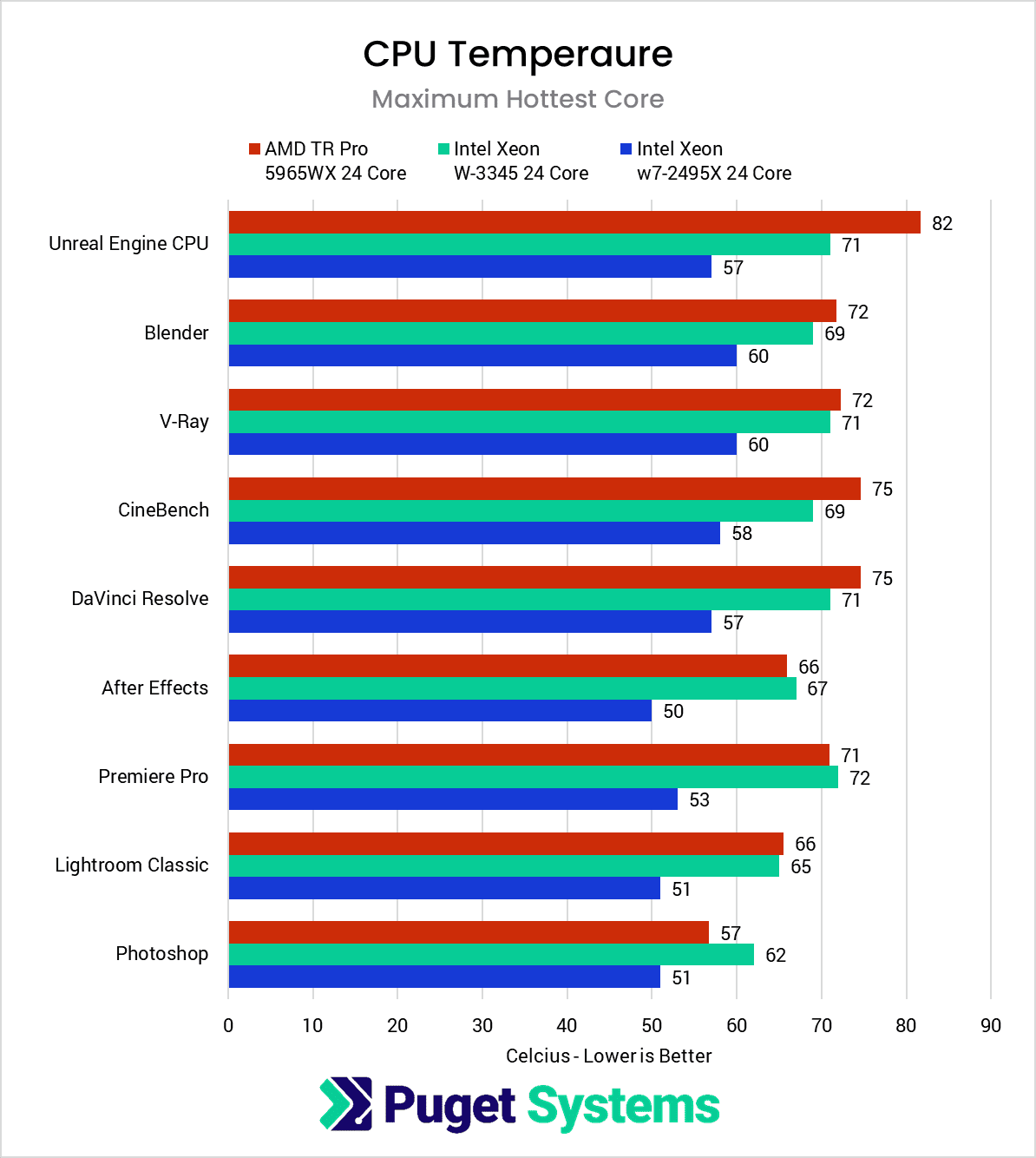
As stated earlier in this section, we are logging CPU temperatures primarily to ensure that we are not close to any thermal throttle limits. Because that is our primary concern, we isolated the maximum temperature from the hottest CPU core during each benchmark.
The CPU core temperature on the new Xeon is definitely much lower than the previous generation Xeon and AMD Threadripper PRO, although we suspect some fan profile differences are at play here. The w7-2495X only consumed a small amount less power than the Threadripper PRO 5975WX, so it shouldn’t be a massive 10C cooler under max load unless there is another factor at play.
Either way, this is plenty to give us complete confidence that we don’t have to worry about thermal throttling being a factor, even under the heaviest CPU loads. We need to stay under 94C on the Xeons, and 95C on Threadripper PRO, to avoid throttling, which we are well below.
Video Editing: DaVinci Resolve Studio
To start off our performance analysis, we will look at one of the more complicated benchmarks: DaVinci Resolve Studio. Many of our benchmarks include an “Overall Score” and various sub-scores for different workflows, and they can sometimes tell a very different story.
Compared to the previous generation Intel Xeon W-3300 processors, the new W-2400 line is significantly faster at the lower core counts, with the w5-2455X 12-core, in particular, out-performing the Xeon W-3323 by 13%. However, the performance gain decreases as we go up in core count, topping out at just a 4% advantage with the new Xeon w7-2495X 24-core compared to the W-3345.
Even with Intel showing large performance gains with some of the new Xeon models, it isn’t enough for them to catch up to AMD. In terms of overall performance, AMD holds a relatively modest 7-8% lead. However, our big concern is how much faster AMD is for the RED/BRAW codecs (chart #4) as these codecs are one of the most common reasons to invest in these CPUs over something like the Intel Core line. While the new Xeons are faster than the previous generation, AMD is so far ahead that even with the performance gains, the Threadripper PRO 5965WX and 5955WX scored 20 and 25% faster than the Xeon w7-2495X and w5-2965X, respectively.
We will note that we currently test DaVinci Resolve Studio with the RED GPU mode set to the default “debayer” mode, rather than using “decompression and debayer”. Switching would offload most of the CPU load when working with RED RAW footage to the GPU, which would mitigate much of this performance disparity. However, since the faster GPU mode can change depending on your workflow (RAW media resolution, compression, framerate, node tree, etc.), we tend to keep our testing to whatever Blackmagic has opted to have as the default.
Video Editing: Adobe Premiere Pro
Unfortunately for Intel, the new Xeon CPUs appear to have some major issues with Adobe Premiere Pro. There are a few areas where the new Xeons do OK, but in general, the new models perform within a few percent of the previous generation. Because of this, AMD is able to maintain their strong lead across the board, with the 5965WX 24 core beating the w7-2495X by 25%, and the 5955WX beating the w5-2465 by 15%.
However, like in DaVinci Resolve, the Intel Xeon W-2400 do particularly poorly when working with RAW media (chart #4). In fact, the new 16 and 24-core Xeons were around 10-15% slower than the previous generation! Combined with AMD’s existing performance lead, that allows the 5975WX and 5965WX to be a massive 44-65% faster than the new Xeon models.
We want to point out that unless you need the additional RAM capacity, we recommend considering the Intel Core i9 13900K rather than the new Xeon W-2400 line. Not only is it a fraction of the price ($570 for the 13900K vs $2,189 for the w7-2495X), but it is simply faster across the board. Plus, the Core i9 13900K includes Intel Quick Sync, allowing you to use hardware decoding for a wider range of HEVC codecs than you can get from a discrete NVIDIA or AMD GPU.
But, if you want to work with RAW media in Premiere Pro, AMD Threadripper PRO is 100% the way to go.
Motion Graphics: After Effects
Adobe After Effects is always interesting to examine as there are two distinct workflows that often dictate what type of CPU you should get (Core/Ryzen or Xeon/Threadripper). The majority of users will be better served by a CPU like the Intel Core 13900K, as it is much faster in most situations than any of the Xeon or Threadripper PRO CPUs we tested. However, Intel Core (and AMD Ryzen) processors have limited RAM capacity (128GB max), which isn’t enough for high-end workflows with long, complex compositions. In addition, those same projects tend to benefit most from the Multi-Frame Rendering (MFR) feature in After Effects, which works best on higher core count CPUs.
Since the main time you would invest in one of these Xeon CPUs is for heavier After Effects projects, we are going to focus on the Multi-Core Score from our benchmark. Feel free to switch to chart #2 if you want to see how these CPUs compare for more typical After Effects projects.
Compared to the previous generation, the new Intel Xeon W-2400 processors see anywhere from a 20% to 36% increase in performance. The benefit is larger at the lower core counts, but even with the w7-2495X we still saw a very impressive 20% gain over the W-3345. While this is only enough to bring the w7-2495X right in line with the AMD Threadripper PRO 5965WX, it allows the w5-2465X to jump ahead of the Threadripper PRO 5955WX by a solid 15% for heavy projects.
Overall, AMD and Intel are very close for After Effects. AMD has a small lead in more typical workflows, but the w5-2465X, in particular, beats AMD for heavier projects.
Graphic Design: Photoshop
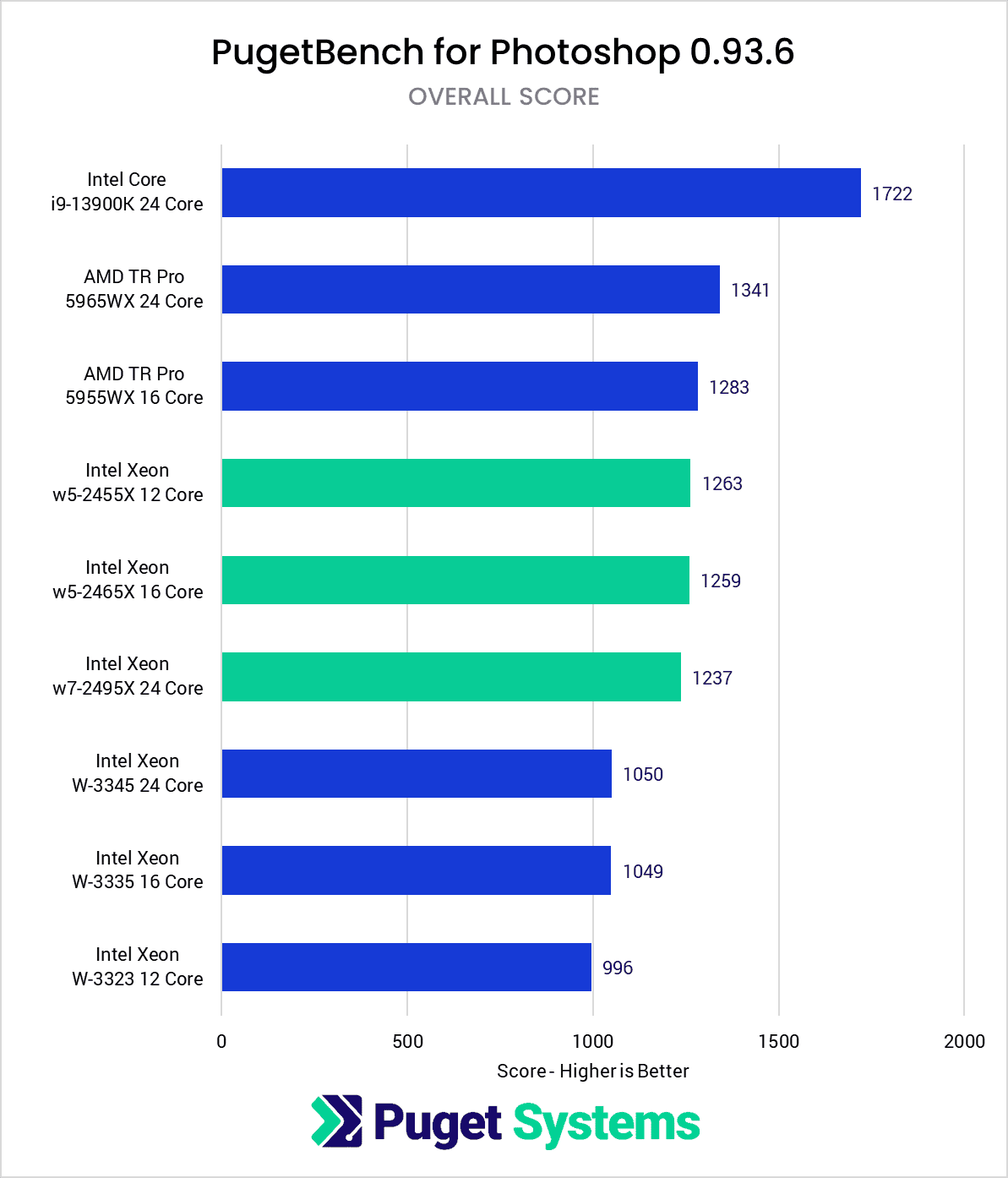
Photoshop is unlikely to be a primary application for anyone looking at this class of processor, but it is extremely common as a secondary app. The reason behind this should be somewhat obvious from how much faster a CPU like the Intel Core i9 13900K is than any Xeon or Threadripper PRO CPUs we tested. Outside of niche workflows that need more than 128GB of RAM, you can save a ton of money and get much higher performance with an Intel Core processor. Because of this, we often include Photoshop more to check for any major issues rather than determining which CPU is necessarily the fastest.
And in that sense, the new Xeons pass with flying colors. Compared to the previous generation, we are seeing a great 18-27% increase in performance, which goes a long way from moving the Xeon CPUs from a “possible concern” to “no problem” in Photoshop. They are still a bit behind their AMD counterparts, but again, this type of workflow is often simply a case of the performance being good enough more than anything else.
Photography: Lightroom Classic
In recent years, we haven’t seen much use for the Intel Xeon or AMD Threadripper PRO processors for Lightroom Classic. In the past, this class of processor was able to give a good boost in performance for those working with thousands of photos at a time, but with the Intel Core 13th Gen and AMD Ryzen 7000 CPUs, that performance benefit has completely evaporated.
With the new Intel Xeon W-2400 processors, we again see a great improvement over the previous generation, this time to the tune of about 20% across the board. That is enough for them to also take the lead in active tasks (scrolling through images, switching modules, etc.) over AMD Theadripper PRO, although AMD holds a solid lead for passive tasks like importing, exporting, and generating previews.
The big takeaway here, however, is that neither AMD Threadripper PRO nor the new Intel Xeon W-2400 line is able to quite catch up to the Intel Core i9 13900K. Unlike After Effects, where it is fairly common to need Xeon or Threadripper for the additional RAM capacity, this isn’t the case in Lightroom Classic very often. In other words, while the new Xeons are a big improvement over the previous generation, the much more affordable Intel Core i9 13900K is going to be the better choice for 99% of Lightroom Classic users.
Game Dev/Virtual Production: Unreal Engine
Unreal Engine has a wide variety of uses, including game development, virtual production, and real-time visualization. Most of the heavy lifting in Unreal Engine is GPU bound, but every user will deal with tasks like compiling shaders which are performed purely on the CPU.
Starting with the top of the new Xeon CPUs, the w7-2495X has mixed results. Compiling shaders is about 24% slower than the Threadrpper Pro 5965WX with the same core count. It is closer to the 16-core Threadripper Pro 5955WX or the 24-core/32-thread Intel Core i9 13900k, which costs a fraction of the price. This is the task that every Unreal Engine user will face to some amount, which makes this a pretty big concern.
On the other hand, building lighting puts the new Xeon slightly ahead of the 5965WX. This isn’t a task that happens too often, and many users, especially in the Virtual Production space, are moving to GPU Lightmass instead. For build servers, or users facing frequent shader compiles, they’d likely be better served with a 32 or 64-core Threadripper. While other users could save a lot of money by using an Intel Core or AMD Ryzen CPU.
Moving down to the 16-core Xeon w57-2465X, this CPU is only about 7% slower than the 16-core Threadripper 5955WX in the shader compilation test, which makes it fairly close on a per-core basis. The Core i9 13900K sits right between the two, which makes sense because while it has more cores, all three CPUs have 32 threads. However, the light building performance falls behind, being 14% slower than the Threadripper.
Lastly, the 12-core Xeon w5-2455 doesn’t have a direct comparison with a Threadripper, but it is about 23% faster than the previous Xeon generation in compiling shaders and 30% faster and building lighting. This is a good generational improvement.
CPU Rendering: Cinebench
Moving on to CPU rendering, this is an area where CPUs with high core counts dominate. AMD has had a lead here for quite some time with their 64-core Threadripper Pro 5995WX. This tier of CPU isn’t what most CPU renderers are looking for, but it is good to see what sort of performance they can expect. In the Cinebench R23 benchmark from Maxon, the new 24-core Xeon does come close to the 24-core Threadripper, being only 3% slower, which is largely within the margin of error. That doesn’t sound like all that much, but it is worth pointing out that this represents a 32% improvement from the previous Xeon.
For single-core performance, the new Xeon takes a 12% lead over the Threadripper. Single-core speeds improve modeling and animation workflows, so this performance is welcome. However, all these workstation-grade CPUs still lag behind the 13900K in single-core speeds, so if modeling performance is a concern, you may want to consider an Intel Core or AMD Ryzen CPU instead.
This continues down the stack with the 16-core Xeon w5-2465. At this level, the new Xeon is tied with the 16-core Threadripper in multi-core performance and roughly 11% faster in single-core workloads. Compared to the previous generation, we see a roughly 30% increase in multi-core and single-core scores.
Likewise, the Intel Xeon w5-2455 12 core posts a 35% improvement in multi- and single-core performance over the Xeon X-3323.
CPU Rendering: V-Ray
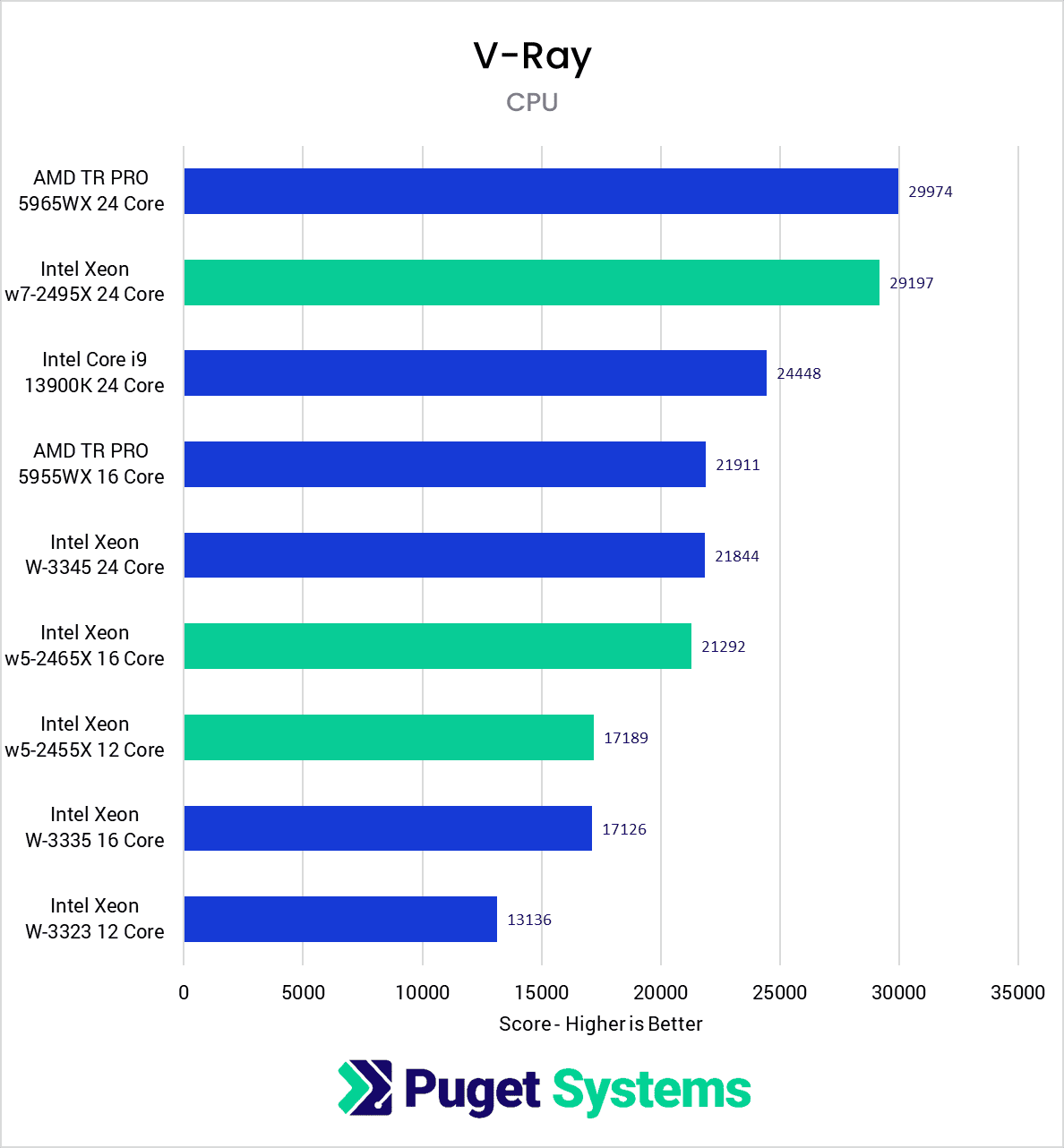
In V-Ray from Chaos, we see results that mirror that of Cinebench. The Xeon w7-2495X is 3% slower than the Threadripper 5965WX. We see the same with the w5-2465X. It, too, is 3% slower than the Threadripper 5955WX. Both of these are roughly 30% faster than their previous counterparts. Moving down the trio of 12-core CPUs, the new Xeon w5-2455S is 30% faster than the previous generation Xeon W-3323.
CPU Rendering: Blender
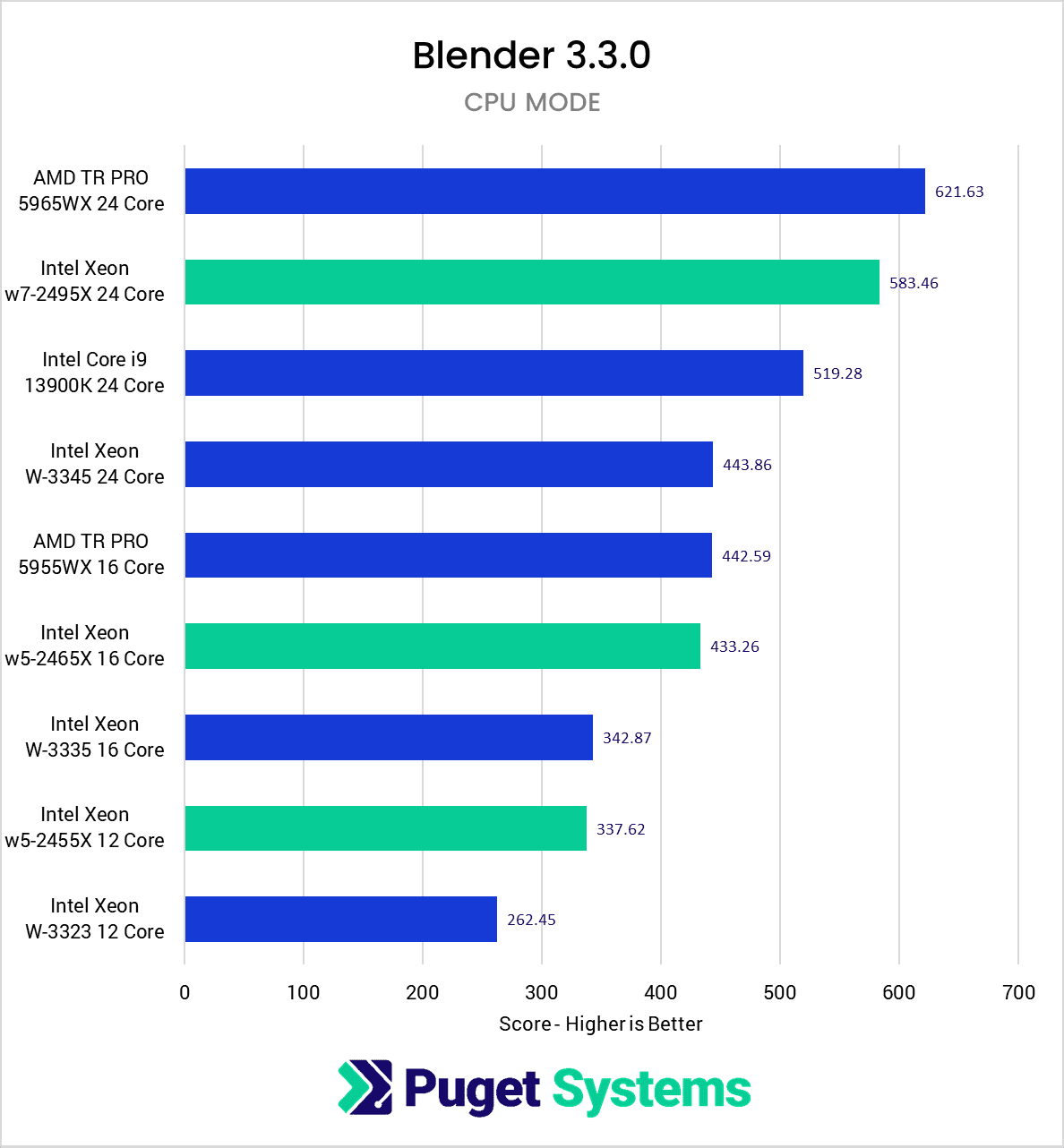
Blender is our final CPU render test. Most Blender users are migrating to GPU rendering, but there are still some cases where CPU is preferred. As we saw in the other rendering benchmarks, the 24-core w7-2495X is 6% slower than AMD’s 24-core offering, the Threadripper Pro 5965WX. Moving on to the 16-core w7-3465X, AMD’s 5955WX lead is only 2%, which could put the two within the margin of error. It should be noted Intel’s Core i9 13900K is roughly 20% faster than either 16-core CPU at a significantly lower price. This makes it difficult to recommend this class of CPU for Blender.
While these are good improvements for Intel, those looking for top CPU rendering performance will want more cores than are offered from the Xeon W-2400 line, or be content with a consumer-grade Intel Core or AMD Ryzen processor paired with GPU rendering.
How Well Do the Intel Xeon W-2400 Processors Perform for Content Creation?
Overall, the new Intel Xeon W-2400 series of processors brings terrific performance gains over the previous generation, along with significantly reduced power consumption. For the Xeon w7-2495 24-core, we saw nearly a 20% increase in performance in lightly threaded applications like Photoshop and Lightroom Classic, and more than a 30% gen-over-gen improvement in heavily threaded tasks like CPU rendering and certain parts of Unreal Engine. And all while consuming about 25% less power.
Unfortunately, however, this performance leap doesn’t translate across the board, and there are a number of rough spots where the performance isn’t nearly as good. In particular, these new processors have some major issues working with RAW media in applications like DaVinci Resolve and Premiere Pro, and in some cases, the performance is actually lower than the previous generation. We hope this is just a bug that will get worked out, but it is very unfortunate as this workflow is one of the main reasons a video editor would invest in a Xeon CPU over something like Intel Core or AMD Ryzen. Instead, AMD Threadripper PRO is by far the better option, at times clocking in at 45-65% faster than the new Xeon W-2400 CPUs.
Luckily, there are plenty of areas where these CPUs are clearly working as intended, and showed massive gains over the previous generation. For example, in Unreal Engine, the new Xeon W-2400 processors showed up to a 30% improvement over the previous generation in specific tasks like building lighting. It isn’t quite enough to overtake the Threadripper Pro CPUs that were released nearly a year ago, but it narrows the gap significantly.
CPU rendering is another area with impressive gains, where the new Xeon CPUs saw roughly a 30% improvement over the previous generation. That is massive, but again, it is only just enough to bring them on par with Threadripper PRO. It should also be noted that if CPU-based rendering is something you are focusing on, you probably are going to want something with more cores than the W-2400 line provides. The Xeon W-3400 line is likely to be a much better option, as they top out at 56 cores.
In general, while the new Xeon W-2400 series is a giant leap in the right direction for Intel, they at best are only able to match AMD’s Threadripper PRO CPUs, and in some areas, still have more work to do before they are a viable option. The good news is that this means that for many workflows, we are back to having multiple option to choose from. We are no longer locked into AMD Threadripper PRO, and you can choose between AMD and Intel based on how the entire platform (not just the raw performance) best fits your entire workflow. However, for many other workflows, AMD continues to hold a solid performance lead.
There are also a number of other solid use cases for these processors due to their wide range of models. Since they are available at lower core counts (and price) than Threadripper PRO, one of the 8 or 12-core models could make an excellent platform for a GPU rendering server, where PCIe lanes are more important than raw CPU power.
It is also worth noting again that the Xeon W-2400 line is only one of several new Xeon processor families that Intel is launching. The Xeon W-3400 (with up to 56 cores and 8-channel memory), in particular, is one that we will be looking at in the near future. We had the opportunity to do an early preview of those processors back in February, and it will be very interesting to see how the platform has matured between that time and now.
If you are looking for a workstation for any of the applications we tested, you can visit our solutions page to view our recommended workstations for various software packages, our custom configuration page, or contact one of our technology consultants for help configuring a workstation that meets the specific needs of your unique workflow.



